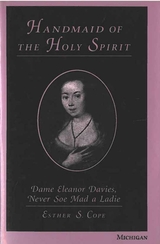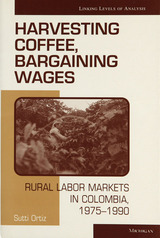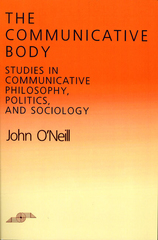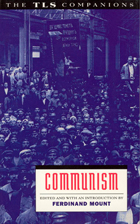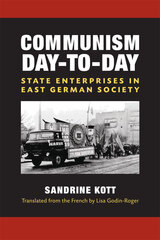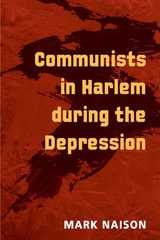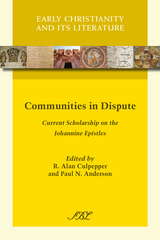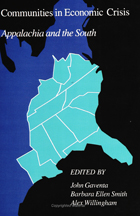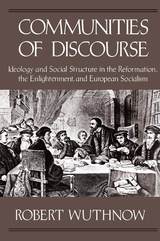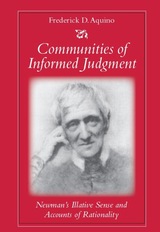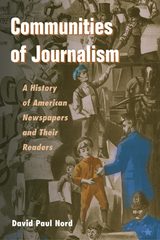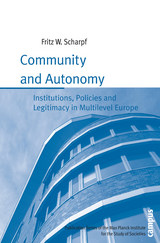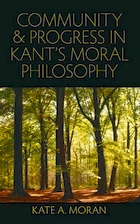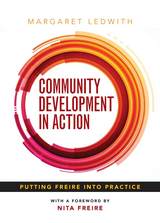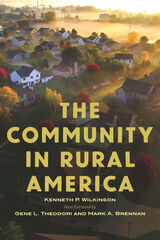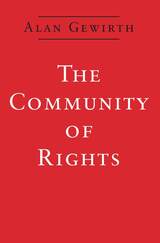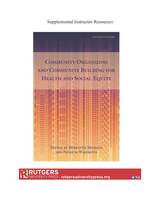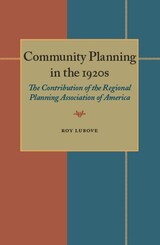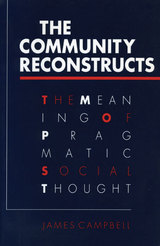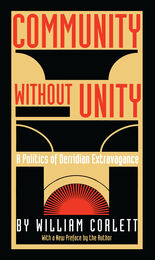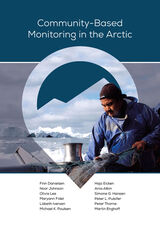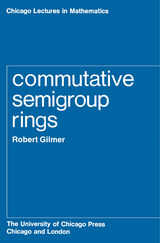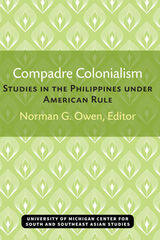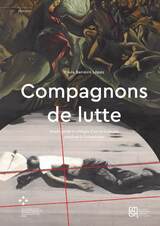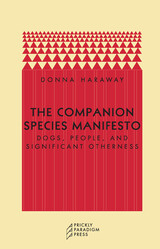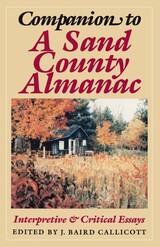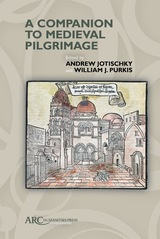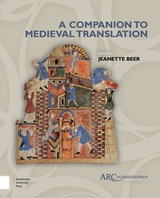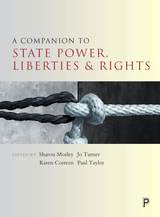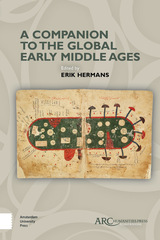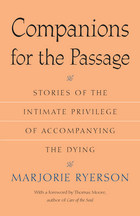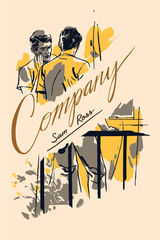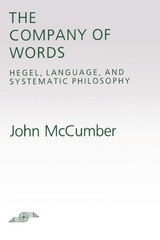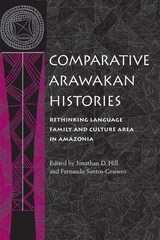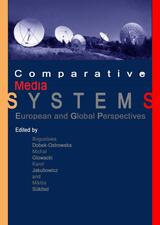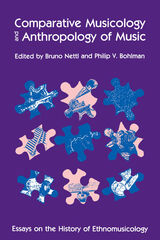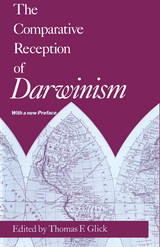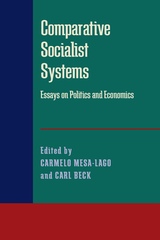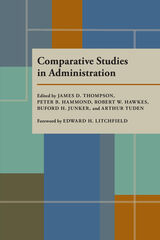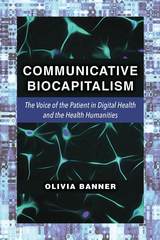 Communicative Biocapitalism: The Voice of the Patient in Digital Health and the Health Humanities
Olivia Banner
University of Michigan Press, 2017 The Precision Medicine Initiative, Apple’s HealthKit, the FitBit—the booming digital health industry asserts that digital networks, tools, and the scientific endeavors they support will usher in a new era of medicine centered around “the voice of the patient.” But whose “voices” do such tools actually solicit? And through what perspective will those voices be heard? Digital health tools are marketed as neutral devices made to help users take responsibility for their health. Yet digital technologies are not neutral; they are developed from an existing set of assumptions about their potential users and contexts for use, and they reflect dominant ideologies of health, dis/ability, gender, and race. Using patient-networking websites, the Quantified Self, and online breast cancer narratives, Communicative Biocapitalism examines the cultural, technological, economic, and rhetorical logics that shape the “voice of the patient” in digital health to identify how cultural understandings and social locations of race, gender, and disability shape whose voices are elicited and how they are interpreted.
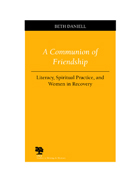 A Communion of Friendship: Literacy, Spiritual Practice, and Women in Recovery
Beth Daniell
Southern Illinois University Press, 2003 Drawing on interviews and an array of scholarly work, Beth Daniell maps out the relations of literacy and spirituality in A Communion of Friendship: Literacy, Spiritual Practice, and Women in Recovery. Daniell tells the story of a group of women in “Mountain City” who use reading and writing in their search for spiritual growth. Diverse in socioeconomic status, the Mountain City women are, or have been, married to alcoholics. In Al-Anon, they use literacy to practice the Twelve Steps of Alcoholics Anonymous in order to find spiritual solutions to their problems. In addition, Daniell demonstrates that in the lives of these women, reading, writing, and speaking are intertwined, embedded in one another in rich and complex ways. For the women, private literate practice is of the utmost importance because it aids the development and empowerment of the self. These women engage in literate practices in order to grow spiritually and emotionally, to live more self-aware lives, to attain personal power, to find or make meaning for themselves, and to create community. By looking at the changes in the women’s reading, Daniell shows that Al-Anon doctrine, particularly its oral instruction, serves as an interpretive tool. This discussion points out the subtle but profound transformations in these women’s lives in order to call for an inclusive notion of politics. Foregrounding the women’s voices, A Communion of Friendship addresses a number of issues important in composition studies and reading instruction. This study examines the meaning of literacy within one specific community, with implications both for pedagogy and for empirical research in composition inside and outside the academy.
Communism: A TLS Companion
Edited by Ferdinand Mount
University of Chicago Press, 1993 From the overthrow of the tsars until the sudden collapse of Soviet communism, the most influential Western analysts have reflected on and debated the rise and fall of communism in the pages of the TLS. The diverse opinions gathered in Communism: A TLS Companion reflect the succession of Western attitudes to the birth, growth, and death of communism.
Contributors to this volume include Isaac Deutscher, Eric Hobsbawm, Richard Pipes, Hugh Seton-Watson, Robert Conquest, Geoffrey Hosking, C. M. Woodhouse, Max Hayward, Leszek Kolakowski, Timothy Garton Ash, and many others of equal distinction. The volume is arranged in four sections covering the period leading to the Russian Revolution, the post-Revolution era of Lenin, Trotsky, and Stalin; the Soviet Union from World War II to 1968; and the final period of disillusionment and collapse.
Communism Day-to-Day: State Enterprises in East German Society
Sandrine Kott
University of Michigan Press, 2014 First published in France in 2001 by Éditions Belin under the title Le communisme au quotidien, Sandrine Kott’s book examines how East German businesses and government carried out communist practices on a daily basis and how citizens and workers experienced the conditions created by the totalitarian state in their daily lives. Kott undertakes a social analysis of the Communist Party’s grasp on state enterprises and the limits of its power. She then analyzes the enterprises themselves and the social, generational, and gender tensions that had a profound impact on the lived experience of socialism. Finally, she considers the development and acceptance of a complex set of rituals and gift exchanges that masked latent conflicts while providing meaning to socialism’s role in ordinary life.
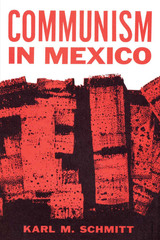 Communism in Mexico: A Study in Political Frustration
By Karl M. Schmitt
University of Texas Press, 1965 The ease with which Cuba slipped into its relationship with Communism revived in the United States its recurring nightmare in which other Latin American countries, particularly Mexico, become satellites of Russia or Red China. But such an occurrence is most unlikely in Mexico, according to Karl Schmitt, former intelligence research analyst with the United States Department of State. Communism in Mexico traces efforts during the early twentieth century to create a Soviet-style society in one of the largest and most strategically situated of the Latin American countries. Schmitt writes authoritatively of the Mexican Communist movement, tracing its development from an early and potentially powerful political-economic base to the increasingly fragmented and weakened collection of parties and front groups of the 1960s. He follows the various schisms and factional divisions to the mid-1950s, when the process of disintegration became most noticeable, and explores and analyzes in detail Communist attempts since then to establish unity among the many quarreling and frustrated groups of the now-splintered movement. Three Communist parties in Mexico, a score of front groups, and numerous infiltration cells in non-Communist organizations such as student and labor groups, all recognize in a broad way a common and ultimate goal: the creation of a Soviet-style society. But their attempts at unity have consistently led only to further bickering and frustration. This period is subjected to a thorough study and analysis in an effort to understand and explain the Communists' lack of success. Schmitt presciently concludes that Communism's future in Mexico will be as cloudy as its past, and that the accelerating economy and improving social conditions there will serve to weaken the movement still further.
Communism, Religion, and Revolt in Banten in the Early Twentieth Century: Mis Sea#86
Michael Williams
Ohio University Press, 1990 Twice in this century popular revolts against colonial rule have occured in the Banten district of West Java. These revolts, conducted largely under an Islamic leadership, also proclaimed themselves Communist. Islamic Communism is seemingly a paradox. This is especially the case when one considers that probably no religion has proved more resistant to Communist ideology than Islam. Michael Williams here details the complicated history of the Bantenese revolts in the twentieth century and probes the ideological riddle of Islamic Communism. Modern history is replete with examples of regions with a long history of organizing themselves politically to resist intrusion on their territory, resources, and people. This book establishes that in Indonesia, the Bantenese were among the most practiced exponents of resistance.
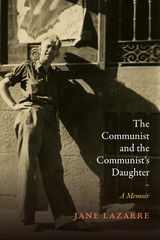 The Communist and the Communist's Daughter: A Memoir
Jane Lazarre
Duke University Press, 2017 In a letter to his baby grandson, Bill Lazarre wrote that "unfortunately, despite the attempts by your grandpa and many others to present you with a better world, we were not very successful." Born in 1902 amid the pogroms in Eastern Europe, Lazarre dedicated his life to working for economic equality, racial justice, workers' rights, and a more just world. He was also dedicated to his family, especially his daughters, whom he raised as a single father following his wife’s death. In The Communist and the Communist's Daughter Jane Lazarre weaves memories of her father with documentary materials—such as his massive FBI file—to tell her father's fascinating history as a communist, a Jew, and a husband, father, and grandfather.
Soon after immigrating to the United States as a young man, Lazarre began a long career as a radical activist, being convicted of sedition, holding leadership positions in the American Communist Party, fighting in the Spanish Civil War, organizing labor unions, testifying in front of the House Un-American Activities Committee, and resisting the FBI’s efforts to recruit him as an informant. Through periods of heroism and deep despair Lazarre never abandoned his ideals or his sustained faith in the fundamental goodness of people.
This is also the story of Jane as she grew up, married an African American civil rights activist, and became a mother and a writer while coming to terms with her father’s legacy. She recounts her arguments with her father over ideology, but also his profound influence on her life. Throughout this poignant and beautifully written work, Jane examines memory, grief, love, and conscience while detailing the sacrifices, humanity, and unwavering convictions of a man who worked tirelessly to create a brighter future for us all.
Communist China, 1955–1959: Policy Documents with Analysis
Robert R. Bowie and John King Fairbank
Harvard University Press The years 1955–1959 in Communist China included striking fluctuations and successes for Mao Tse-tung’s Party, and the working out of the first Five-Year Plan for economic and agricultural development. Here analysis of domestic developments is supported by 48 documents—directives, speeches, and articles. The major Party pronouncements are given in full. The significance of each is clarified by prefatory comments indicating additional readings, and by the 41-page introductory essay. This newly integrated picture of five crucial years pioneers the use of documentation (as in Soviet studies) for dealing with Communist China.
 Communist Gourmet: The Curious Story of Food in the People’s Republic of Bulgaria
Albena Shkodrova
Central European University Press, 2021 Communist Gourmet presents a lively, detailed account of how the communist regime in Bulgaria determined people’s everyday food experience between 1944 and 1989. It examines the daily routines of acquiring food, cooking it, and eating out at restaurants through the memories of Bulgarians and foreigners, during communism. In looking back on a wide array of issues and events, Albena Shkodrova attempts to explain the paradoxes of daily existence. She reports human stories that are touching, sometimes dark, but often full of humor and anecdotes from nearly one hundred people: some of them are Bulgarians who were involved in the communist food industry, whether as consumers or employees, while others are visitors from the United States and Western Europe who report culinary highlights and disappointments. The author made use of the national press, officially published cookbooks, Communist Party documents, and other previously unstudied sources. An appendix containing recipes of dishes typical of the period and an extensive set of archival photographs are special features of the volume.
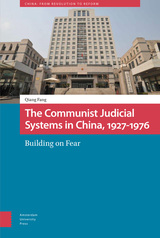 The Communist Judicial System in China, 1927-1976: Building on Fear
Qiang Fang
Amsterdam University Press, 2021 Drawing on hundreds of newly released judicial archives and court cases, this book analyzes the communist judicial system in China from its founding period to the death of Mao Zedong. It argues that the communist judicial system was built when the CCP was engaged in a life-or-death struggle with the GMD, meaning that the overriding aim of the judicial system was, from the outset, to safeguard the Party against both internal and external adversaries. This fundamental insecurity and perennial fear of loss of power obsessed the Party throughout the era of Mao and beyond, prompting it to launch numerous political campaigns, which forced communist judicial cadres to choose between upholding basic legal norms and maintaining Party order. In doing all of this, The Communist Judicial System in China, 1927-1976: Building on Fear fills a major lacuna in our understanding of communist-era China.
 A Communist Odyssey: The life of József Pogány/John Pepper
Thomas Sakmyster
Central European University Press, 2012 A group of Central European communists, most of them Hungarians, in the interwar period served the world communist movement as international cadres of the Comintern, the Moscow-based Communist International. As an important member of this cohort, József Pogány played a major role in the Hungarian Soviet Republic of 1919, the "March Action" in Germany in 1921, and, under the name of John Pepper, in the development of the American Communist Party of the 1920s. During the 1920s he was an important official in the Comintern apparatus and undertook missions on three continents. A prolific writer and effective organizer, he was one of the most flamboyant and controversial communists of his era. Some of his comrades praised him as "the Hungarian Christopher Columbus." Others, like Trotsky, called him a "political parasite."This study is based on newly available primary sources from Hungary, Russia, and the United States; it is the first ever written about this colorful and well-travelled Hungarian communist. Examines Pogány's development as a socialist and communist, the influence of his Jewish origins on his career, the reasons for his remarkable success in the United States, and the circumstances that led to his arrest and execution in the Stalinist terror.
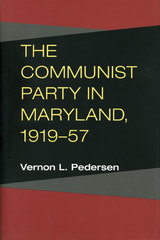 The Communist Party in Maryland, 1919-57
Vernon L. Pedersen
University of Illinois Press, 2001 This rare grass-roots account of American communism traces the rise and fall of Maryland's Communist Party from the time of the Russian Revolution to the McCarthy era. Drawing on sources including the central archives of the Communist Party of the United States of America, recovered from remote storage in Siberia in 1993, Vernon L. Pedersen presents a sharp challenge to revisionist views of American communism as a benign domestic movement detached from Soviet interests.
Bolsheviks in Baltimore charts the uneven transformation of Baltimore's fledgling Communists into underground revolutionaries in the 1920s. Pedersen documents the mercurial careers of local organizers, their devotion to the Soviet cause, and their efforts to convert the Party from a hodgepodge of ethnic groups to an effective instrument of class interests. He also tracks the public's changing perception of the Communists, from amused unconcern to alarm, and details how the Ober antisubversive law and the HUAC hearings of the 1950s dismantled the Party from without while planting seeds of paranoia that destroyed it from within.
Behind the public fear of a Communist conspiracy against the U.S. government, Pedersen finds a party fractured by conflicting agendas, ineffectual leadership, and unstable membership. However, he also uncovers new evidence that Communists in the United States, acting on Soviet orders, used their influence in unions and front groups to sway American foreign policy in ways that benefited the Soviet Union. He documents the consolidation of an espionage apparatus in Baltimore and demonstrates that while espionage activities may have involved only a few individuals, all Party members shared an attitude of willing support for the activities of the Soviet Union that made these covert practices possible.
Paying tribute to the fervor and the effort dedicated by the Maryland Communists, often at the expense of their own physical and financial well-being, to a cause that ultimately failed them, Bolsheviks in Baltimore assesses an ambiguous legacy of admirable social vision, haphazard international conspiracy, and fierce internal conflict.
 The Communist States in Disarray, 1965-1971
Adam Bromke and Teresa Rakowska-Harmstone, Editors
University of Minnesota Press, 1972
The Communist States in Disarray, 1965–1971 was first published in 1972. Minnesota Archive Editions uses digital technology to make long-unavailable books once again accessible, and are published unaltered from the original University of Minnesota Press editions.
Through a survey and analysis of recent developments in the communist states and in their relations with one another and with other nations this volume provides a revealing picture of a changing communist world. Indeed, as the book makes clear, it is no longer appropriate to think of the communist countries as one world, since a major development during the period covered in this study has been the disintegration of the communist monolith and the reemergence of separate national entities in Eastern Europe.
The sixteen chapters by fifteen contributors provide studies of the individual communist states as well as several chapter-length discussions of general trends and patterns. The contributors also project the likely course of developments for the rest of the 1970s. Throughout the book the twin themes of an aggregation of the Sino-Soviet conflict and the spread of nationalism point to the conclusion that the communist states are now in disarray.
The contents: Patters of Political change, Teresa Rakowska-Harmstone; Polycentrism in Eastern Europe, Adam Bromke; The Sino-Soviet Dispute, John W. Strong; Czechoslovakia, H, Gordon Skilling; East Germany, Melvin Croan; Rumania, Gabriel Fischer; Yugoslavia, John C. Campbell; Albania, Peter R. Prifti; Outer Mongolia, Paul F. Langer; North Korea and North Vietnam, Paul F. Langer; Cuba, C. Ian Lumsden; Patterns of Economic Relations, Philip E. Uren; External Forces in Eastern Europe, Andrew Gyorgy.
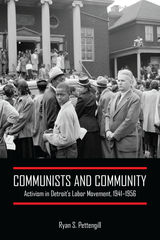 Communists and Community: Activism in Detroit's Labor Movement, 1941-1956
Ryan S. Pettengill
Temple University Press, 2020 Communists and Community seeks to reframe the traditional chronology of the Communist Party in the United States as a means to better understand the change that occurred in community activism in the mid-twentieth century. Ryan Pettengill argues that Popular Front activism continued to flourish throughout the war years and into the postwar period. In Detroit, where there was a critical mass of heavy industry, Communist Party activists mobilized support for civil rights and affordable housing, brought attention to police brutality, sought protection for the foreign-born, and led a movement for world peace. Communists and Community demonstrates that the Communist Party created a social space where activists became effective advocates for the socioeconomic betterment of a multiracial work force. Pettengill uses Detroit as a case study to examine how communist activists and their sympathizers maintained a community to enhance the quality of life for the city’s working class. He investigates the long-term effects of organized labor’s decision to force communists out of the unions and abandon community-based activism. Communists and Community recounts how leftists helped workers, people of color, and other under-represented groups became part of the mainstream citizenry in America.
Communists in Harlem during the Depression
Mark Naison
University of Illinois Press, 2004 Winner of the Ralph Bunche Award, American Political Science Association No socialist organization has ever had a more profound effect on black life than the Communist Party did in Harlem during the Depression. Mark Naison describes how the party won the early endorsement of such people as Adam Clayton Powell Jr. and how its support of racial equality and integration impressed black intellectuals, including Richard Wright, Langston Hughes, and Paul Robeson. This meticulously researched work, largely based on primary materials and interviews with leading black Communists from the 1930s, is the first to fully explore this provocative encounter between whites and blacks. It provides a detailed look at an exciting period of reform, as well as an intimate portrait of Harlem in the 1920s and 30s, at the high point of its influence and pride.
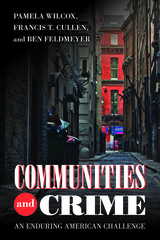 Communities and Crime: An Enduring American Challenge
Pamela Wilcox
Temple University Press, 2017 Social scientists have long argued over the links between crime and place. The authors of Communities and Crime provide an intellectual history that traces how varying images of community have evolved over time and influenced criminological thinking and criminal justice policy. The authors outline the major ideas that have shaped the development of theory, research, and policy in the area of communities and crime. Each chapter examines the problem of the community through a defining critical or theoretical lens: the community as social disorganization; as a system of associations; as a symptom of larger structural forces; as a result of criminal subcultures; as a broken window; as crime opportunity; and as a site of resilience. Focusing on these changing images of community, the empirical adequacy of these images, and how they have resulted in concrete programs to reduce crime, Communities and Crime theorizes about and reflects upon why some neighborhoods produce so much crime. The result is a tour of the dominant theories of place in social science today.
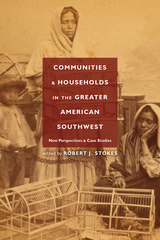 Communities and Households in the Greater American Southwest: New Perspectives and Case Studies
Robert J. Stokes
University Press of Colorado, 2019 Communities and Households in the Greater American Southwest presents new research on human organization in the American Southwest, examining families, households, and communities in the Ancestral Puebloan, Mogollon, and Hohokam major cultural areas, as well as the Fremont, Jornada Mogollon, and Lipan Apache areas, from the time of earliest habitation to the twenty-first century. Using historical data, dialectic approaches, problem-oriented and data-driven analysis, and ethnographic and gender studies methodologies, the contributors offer diverse interpretations of what constitutes a site, village, and community; how families and households organized their domestic space; and how this organization has influenced researchers’ interpretations of spatially derived archaeological data.
Today’s archaeologists and anthropologists understand that communities operate as a multi-level, -organizational, -contextual, and -referential human creation, which informs their understanding of how people actively negotiate their way through and around community constraints. The chapters in this book creatively examine these interactions, revealing the dynamic nature of ancient and modern groups in the American Southwest. The book has two broad complementary themes: one focusing on household decision-making, identity, and structural relations with the greater community; the other concerned with community organization and integration, household roles within the community, and changes in community organization—violence and destabilization, coalescence and cooperation—over time.
Communities and Households in the Greater American Southwest weaves a rich tapestry of ancient and modern life through innovative approaches that will be of interest not only to Southwestern archaeologists but to all researchers and students interested in social organization at the household and community levels.
Contributors: James R. Allison, Andrew Duff, Lindsay Johansson, Michael Lindeman, Myles Miller, James Potter, Alison E. Rautman, J. Jefferson Reid, Katie Richards, Oscar Rodriguez, Barbara Roth, Kristin Safi, Deni Seymour, Robert J. Stokes, Richard K. Talbot, Scott Ure, Henry Wallace, Stephanie M. Whittlesey
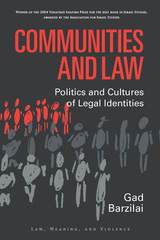 Communities and Law: Politics and Cultures of Legal Identities
Gad Barzilai
University of Michigan Press, 2005 "Relying on theories of politics, law, and society, Barzilai offers a 'critical communitarian' solution that views non-ruling communities as cultural foci of mobilization. His thoughtful analysis contributes to key theoretical discussions of the relationship between communitarianism and national minorities: feminism and religious fundamentalism. This insightful book explores the continuum of litigation to violence in the broader context of politics of identity. . . . Highly recommended."
--Choice
"A remarkable achievement."
--Malcolm Feeley, University of California, Berkeley
"A rich, subtle, and wide-ranging analysis of the complex interaction between law and culture in Israeli society."
--Pnina Lahav, Boston University School of Law
"Barzilai makes a major contribution to thinking about state-society relations, pointing researchers to the plurality of communities harboring different sorts of legal identities, consciousness, and practices."
--Joel Migdal, University of Washington
Communities and Law examines the intersection of communities, cultures, and laws in public life, asking important questions about how nonruling communities confront the law in their efforts to achieve political goals.
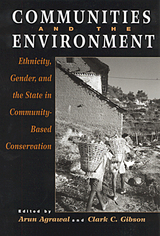 Communities and The Environment: Ethnicity, Gender, and the State in Community-Based Conservation
Agrawal, Arun
Rutgers University Press, 2001 For years environmentalists thought natural resources could be best protected by national legislation. But the poor outcomes of this top-down policy have led conservation professionals today to regard local communities as the agents of conservation efforts. According to a recent survey, more than fifty countries report that they pursue partnerships with local communities in an effort to protect their forests. Despite the recent popularity of a community-based approach, the concept of community rarely receives the attention it should get from those concerned with resource management. This balanced volume redresses the situation, demonstrating both the promise and the potential dangers of community action.
Although the contributors advocate community-based conservation, they examine the record with a critical eye. They pay attention to the concrete political contexts in which communities emerge and operate. Understanding the nature of community requires understanding the internal politics of local regions and their relationship to external forces and actors. Especially critical are issues related to ethnicity, gender, and the state.
Communities in Dispute: Current Scholarship on the Johannine Epistles
R. Alan Culpepper
SBL Press, 2014 Presenting the best work on the Johannine Epistles from a world-class gathering of scholars
This anthology includes papers presented at the McAfee School of Theology Symposium on the Johannine Epistles (2010). Contributions on the relationship between the Gospel of John and the Letters of John, Johannine theology and ethics, the concept of the Antichrist, and the role of the elder round out the collection. This is a must-have book for libraries and New Testament scholars.
Features:
- Introductory essay places the collection in context
- Articles engage the work of Raymond Brown and J. Louis Martyn
- Sixteen essays from the Book of Psalms Consultation group and invited scholars
Communities In Economic Crisis
edited by John Gaventa, Barbara Ellen Smith and Alex Willingham
Temple University Press, 1990 Hard times are no stranger to the people of Appalachia and the South. Earlier books have documented the low wages of the textile industry, boom-and-bust cycles of coal mining, and debt peonage of Southern agriculture that have established a heritage of poverty that endures. This book is a unique collection of essays by people who are actively involved in the efforts to challenge economic injustice in these regions and to empower the residents to build democratic alternatives.
In the series Labor and Social Change, edited by Paula Rayman and Carmen Sirianni.
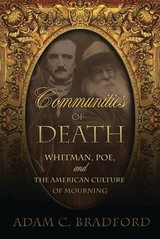 Communities of Death: Whitman, Poe, and the American Culture of Mourning
Adam C. Bradford
University of Missouri Press, 2014 To 21st century readers, 19th century depictions of death look macabre if not maudlin—the mourning portraits and quilts, the postmortem daguerreotypes, and the memorial jewelry now hopelessly, if not morbidly, distressing. Yet this sentimental culture of mourning and memorializing provided opportunities to the bereaved to assert deeply held beliefs, forge social connections, and advocate for social and political change. This culture also permeated the literature of the day, especially the works of Edgar Allan Poe and Walt Whitman. In Communities of Death, Adam C. Bradford explores the ways in which the ideas, rituals, and practices of mourning were central to the work of both authors. While both Poe and Whitman were heavily influenced by the mourning culture of their time, their use of it differed. Poe focused on the tendency of mourners to cling to anything that could remind them of their lost loved ones; Whitman focused not on the mourner but on the soul’s immortality, positing an inevitable reunion. Yet Whitman repeatedly testified that Poe’s Gothic and macabre literature played a central role in spurring him to produce the transcendent Leaves of Grass. By unveiling a heretofore marginalized literary relationship between Poe and Whitman, Bradford rewrites our understanding of these authors and suggests a more intimate relationship among sentimentalism, romanticism, and transcendentalism than has previously been recognized. Bradford’s insights into the culture and lives of Poe and Whitman will change readers’ understanding of both literary icons.
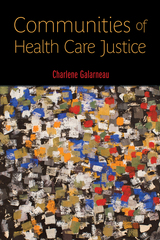 Communities of Health Care Justice
Galarneau, Charlene
Rutgers University Press, 2016 The factions debating health care reform in the United States have gravitated toward one of two positions: that just health care is an individual responsibility or that it must be regarded as a national concern. Both arguments overlook a third possibility: that justice in health care is multilayered and requires the participation of multiple and diverse communities. Communities of Health Care Justice makes a powerful ethical argument for treating communities as critical moral actors that play key roles in defining and upholding just health policy. Drawing together the key community dimensions of health care, and demonstrating their neglect in most prominent theories of health care justice, Charlene Galarneau postulates the ethical norms of community justice. In the process, she proposes that while the subnational communities of health care justice are defined by shared place, including those bound by culture, religion, gender, and race that together they define justice. As she constructs her innovative theorization of health care justice, Galarneau also reveals its firm grounding in the work of real-world health policy and community advocates. Communities of Health Care Justice not only strives to imagine a new framework of just health care, but also to show how elements of this framework exist in current health policy, and to outline the systemic, conceptual, and structural changes required to put these justice norms into fuller practice.
 Communities of Honor and Love in Henry James
Manfred Mackenzie
Harvard University Press, 1976 Here is a study of the essential Henry James, a study that delineates the development of his imagination, not in a strictly chronological way but by isolating patterns that can be applied to his work as a whole. Manfred Mackenzie analyzes James's social imagination, examining the kind of society and social structure he tended to portray and the motivations of his characters.
The experience of exposure, the author argues, is met with everywhere in James: identity and honor sought, won, or lost. Secrecy, or the use of secrecy in conspiracy, is a reaction to exposure, and cabal and conspiracy are consistently an element in the protagonists' quests. As James matured, however, he seemed to realize that identity and honor are ambiguous, and ultimately dehumanizing; a different set of values was needed. Mackenzie argues that a final plane of experience steadily emerges in James's work, that of love as manifested in the capacity to sacrifice identity and honor.
Communities of Informed Judgment: Newman's Illative Sense and Accounts of Rationality
Frederick D. Aquino
Catholic University of America Press, 2004 An original contribution to Newman studies, the book has an interdisciplinary focus, drawing from recent work in social epistemology, virtue epistemology, and cognitive science. It also takes up issues relevant to the philosophy of religion, epistemology of religious belief, systematic theology, ecumenical dialogue, and studies in John Henry Newman.
Communities of Journalism: A History of American Newspapers and Their Readers
David Paul Nord
University of Illinois Press, 2006 Widely acknowledged as one of our most insightful commentators on the history of journalism in the United States, David Paul Nord reveals how newspapers have intersected with religion, politics, reform, and urban life over nearly three centuries, His lively and wide-ranging discussion shows journalism to be a vital component of community. Ranging from the religion-infused towns of colonial America to the rapidly expanding urban metropolises of the late nineteenth century, Nord explores the cultural work of the press and how ordinary readers use journalism to form community attachments and engage in civic life.
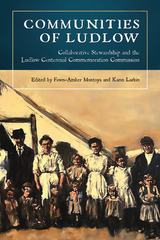 Communities of Ludlow: Collaborative Stewardship and the Ludlow Centennial Commemoration Commission
Fawn-Amber Montoya
University Press of Colorado, 2021 For more than one hundred years, people have come to the Ludlow Massacre Memorial site to remember the dead, to place themselves within a larger narrative of labor history, and to learn about what occurred there. Communities of Ludlow reveals the perseverance, memory, and work that has been done to enrich and share the narratives of the people of Ludlow and the experiences of those who commemorate it.
The history of the Ludlow Massacre encompasses the stories of immigrant groups, women, the working-class, and people of color as much as the story of that tragedy, and the continued relevance of these issues creates a need for remembrance and discussion of how to make the events of the Ludlow Massacre available to contemporary society. The book outlines recent efforts to remember and commemorate this important historical event, documenting the unique collaborations in public scholarship and outreach among the diverse group of people involved in marking the 100-year anniversary of the Ludlow Massacre. The chapters relate the tales of the stewards of the Ludlow Massacre—the various communities that rallied together to keep this history alive and show its relevance, including lineal descendants, members of the United Mine Workers of America, historians, archaeologists, scholars, artists, interpreters, authors, playwrights, and politicians. The book also offers tips, strategies, and cautionary tales for practicing engaged public scholarship.
The history of the Ludlow Massacre has been told as a tragedy of striking miners in the West that occurred during a turbulent time in US labor relations, but it is so much more than that. Communities of Ludlow explores the intersections of public scholarship, advocacy, and personal experience, weaving these perspectives together with models for practicing public scholarship to illustrate the power of creating spaces for sharing ideas and information in an environment that encourages creativity, open dialogue, public outreach, political action, and alternative narratives.
Contributors: Robert Butero, Robin Henry, Michael Jacobson, Elizabeth Jameson, Linda Linville, Matthew Maher, Yolanda Romero
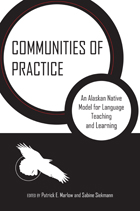 Communities of Practice: An Alaskan Native Model for Language Teaching and Learning
Edited by Patrick E. Marlow and Sabine Siekmann
University of Arizona Press, 2013 Educators, scholars, and community activists recognize that immersion education is a key means to restoring Indigenous and other heritage languages. But language maintenance and revitalization involve many complex issues, foremost may be the lack of local professional development opportunities for potential language teachers. In Alaska, the Second Language Acquisition Teacher Education (SLATE) project was designed to enable Indigenous communities and schools to improve the quality of native-language and English-language instruction and assessment by focusing on the elimination of barriers that have historically hindered degree completion for Indigenous and rural teachers. The Guided Research Collaborative (GRC) model, was employed to support the development of communities of practice through near-peer mentoring and mutual scaffolding. Through this important new model, teachers of both the heritage language, in this case Central Yup’ik, and English were able to situate their professional development into a larger global context based on current notions of multilingualism. In Communities of Practice contributors show how the SLATE program was developed and implemented, providing an important model for improving second-language instruction and assessment. Through an in-depth analysis of the program, contributors show how this project can be successfully adapted in other communities via its commitment to local control in language programming and a model based on community-driven research. Communities of Practice demonstrates how an initial cohort of Yup’ik- and English-language teachers collaborated to negotiate and ultimately completed the SLATE program. In so doing, these educators enhanced the program and their own effectiveness as teachers through a greater understanding of language learning. It is these understandings that will ultimately allow heritage- and English-language teachers to work together to foster their students’ success in any language.
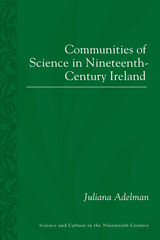 Communities of Science in Nineteenth-Century Ireland
Juliana Adelman
University of Pittsburgh Press, 2009 The nineteenth century was an important period for both the proliferation of "popular" science and for the demarcation of a group of professionals that we now term scientists. Of course for Ireland, largely in contrast to the rest of Britain, the prominence of Catholicism posed various philosophical questions regarding research.
Adelman’s study examines the practical educational impact of the growth of science in these communities, and the impact of this on the country’s economy; the role of museums and exhibitions in spreading scientific knowledge; and the role that science had to play in Ireland’s turbulent political context.
Adelman challenges historians to reassess the relationship between science and society, showing that the unique situation in Victorian Ireland can nonetheless have important implications for wider European interpretations of the development of this relationship during a period of significant change.
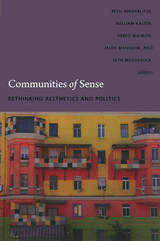 Communities of Sense: Rethinking Aesthetics and Politics
Beth Hinderliter, William Kaizen, Vered Maimon, Jaleh Mansoor, and Seth McCormick, eds.
Duke University Press, 2009 Communities of Sense argues for a new understanding of the relation between politics and aesthetics in today’s globalized and image-saturated world. Established and emerging scholars of art and culture draw on Jacques Rancière’s theorization of democratic politics to suggest that aesthetics, traditionally defined as the “science of the sensible,” is not a depoliticized discourse or theory of art, but instead part of a historically specific organization of social roles and communality. Rather than formulating aesthetics as the Other to politics, the contributors show that aesthetics and politics are mutually implicated in the construction of communities of visibility and sensation through which political orders emerge. The first of the collection’s three sections explicitly examines the links between aesthetics and social and political experience. Here a new essay by Rancière posits art as a key site where disagreement can be staged in order to produce new communities of sense. In the second section, contributors investigate how sense was constructed in the past by the European avant-garde and how it is mobilized in today’s global visual and political culture. Exploring the viability of various models of artistic and political critique in the context of globalization, the authors of the essays in the volume’s final section suggest a shift from identity politics and preconstituted collectivities toward processes of identification and disidentification. Topics discussed in the volume vary from digital architecture to a makeshift museum in a Paris suburb, and from romantic art theory in the wake of Hegel to the history of the group-subject in political art and performance since 1968. An interview with Étienne Balibar rounds out the collection. Contributors. Emily Apter, Étienne Balibar, Carlos Basualdo, T. J. Demos, Rachel Haidu, Beth Hinderliter, David Joselit, William Kaizen, Ranjanna Khanna, Reinaldo Laddaga, Vered Maimon, Jaleh Mansoor, Reinhold Martin, Seth McCormick, Yates McKee, Alexander Potts, Jacques Rancière, Toni Ross
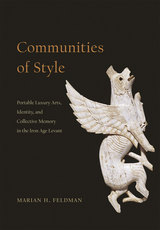 Communities of Style: Portable Luxury Arts, Identity, and Collective Memory in the Iron Age Levant
Marian H. Feldman
University of Chicago Press, 2014 Communities of Style examines the production and circulation of portable luxury goods throughout the Levant in the early Iron Age (1200–600 BCE). In particular it focuses on how societies in flux came together around the material effects of art and style, and their role in collective memory.
Marian H. Feldman brings her dual training as an art historian and an archaeologist to bear on the networks that were essential to the movement and trade of luxury goods—particularly ivories and metal works—and how they were also central to community formation. The interest in, and relationships to, these art objects, Feldman shows, led to wide-ranging interactions and transformations both within and between communities. Ultimately, she argues, the production and movement of luxury goods in the period demands a rethinking of our very geo-cultural conception of the Levant, as well as its influence beyond what have traditionally been thought of as its borders.
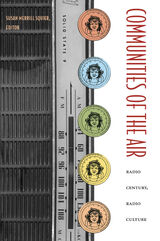 Communities of the Air: Radio Century, Radio Culture
Susan Merrill Squier, ed.
Duke University Press, 2003 A pioneering analysis of radio as both a cultural and material production, Communities of the Air explores radio’s powerful role in shaping Anglo-American culture and society since the early twentieth century. Scholars and radio writers, producers, and critics look at the many ways radio generates multiple communities over the air—from elite to popular, dominant to resistant, canonical to transgressive. The contributors approach radio not only in its own right, but also as a set of practices—both technological and social—illuminating broader issues such as race relations, gender politics, and the construction of regional and national identities. Drawing on the perspectives of literary and cultural studies, science studies and feminist theory, radio history, and the new field of radio studies, these essays consider the development of radio as technology: how it was modeled on the telephone, early conflicts between for-profit and public uses of radio, and amateur radio (HAMS), local programming, and low-power radio. Some pieces discuss how radio gives voice to different cultural groups, focusing on the BBC and poetry programming in the West Indies, black radio, the history of alternative radio since the 1970s, and science and contemporary arts programming. Others look at radio’s influence on gender (and gender’s influence on radio) through examinations of Queen Elizabeth’s broadcasts, Gracie Allen’s comedy, and programming geared toward women. Together the contributors demonstrate how attention to the variety of ways radio is used and understood reveals the dynamic emergence and transformation of communities within the larger society.
Contributors. Laurence A. Breiner, Bruce B. Campbell, Mary Desjardins, Lauren M. E. Goodlad, Nina Hunteman, Leah Lowe, Adrienne Munich, Kathleen Newman, Martin Spinelli, Susan Merrill Squier, Donald Ulin, Mark Williams, Steve Wurzler
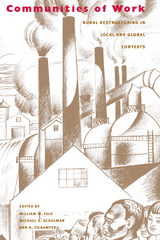 Communities of Work: Rural Restructuring in Local and Global Contexts
William W. Falk
Ohio University Press, 2003 The image of rural America portrayed in this illuminating study is one that is vibrant, regionally varied, and sometimes heroic. Communities of Work focuses on the ways in which rural people and places are affected by political, social, and economic forces far outside their control and how they sustain themselves and their communities in response. Bringing together the two fundamental concepts of community—where the relationships and practices of daily life occur—and work, in which an elementary exchange occurs, Communities of Work bridges several fields of study. Presented here is the contextual and embedded nature of social relations and the complexity involved in understanding them. Through the use of multiple case studies, the authors apply diverse theories and methods in seeking an integrated outcome, one captured by “communities of work.” Beginning with a description of the broad changes in work and economic activities across the United States, ranging from the Ohio River Valley to a western boomtown, the book shifts its focus to the interplay of work, family, and local networks in time and place. Activities range from fishing in the Mississippi Delta to farming and family life in the Midwest. The authors then highlight how rural people and places respond to extra-local, increasingly global forces in settings as diverse as rural South Carolina and Wisconsin. A certain communitarian theme runs through Communities of Work. It is about people and communities not merely reacting, but instead responding in ways that reflect their local culture, while being cognizant of the larger world within which they live.
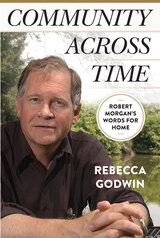 Community across Time: Robert Morgan’s Words for Home
Rebecca Godwin
West Virginia University Press, 2023 One of the first book-length considerations of the Appalachian writer Robert Morgan.
One of the first book-length studies of Robert Morgan, Community across Time considers the Appalachian writer’s explorations of memory, family history, and landscape. It provides a study of all of Morgan’s fiction to date, as well as a chapter on his poetry and some reference, where appropriate, to his nonfiction. Rebecca Godwin examines the family history that informs much of this body of work, offering an extended biographical essay that ties characters and plot details to Morgan’s ancestors’ lives and to his own experiences growing up in the Blue Ridge Mountains. Religious rifts, economic hardships, class conflicts, the place of women and Indigenous peoples, and the failure of humans to recognize the divinity of the natural world are among the motifs centering Morgan’s writing. Community across Time explores those themes as it looks to Morgan’s relationship to the Appalachian South.
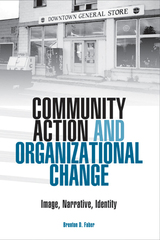 Community Action and Organizational Change: Image, Narrative, Identity
Brenton D. Faber
Southern Illinois University Press, 2002 Brenton D. Faber’s spirited account of an academic consultant’s journey through banks, ghost towns, cemeteries, schools, and political campaigns explores the tenuous relationships between cultural narratives and organizational change. Blending Faber’s firsthand experiences in the study and implementation of change with theoretical discussions of identity, agency, structure, and resistance within contexts of change, this innovative bookis among the first such communications studies to profile a scholar who is also a full participant in the projects. Drawing on theories of Michel Foucault, Anthony Giddens, and Pierre Bourdieu, Faber notes that change takes place in the realm of narrative, in the stories people tell. Faber argues that an organization’s identity is created through internal stories. When the organization’s internal stories are consistent with its external stories, the organization’s identity is consistent and productive. When internal stories contradict the external stories, however, the organization’s identity becomes discordant. Change is the process of realigning an organization’s discordant narratives. Faber discusses the case studies of a change management plan he wrote for a city-owned cemetery, a cultural change project he created for a downtown trade school, and a political campaign he assisted that focused on creating social change. He also includes detailed reflections on practical ways academics can become more involved in their communities as agents of progressive social change. Featuring six illustrations, Faber’s unique study demonstrates in both style and substance how stories work as agents of change.
Community and Autonomy: Institutions, Policies and Legitimacy in Multilevel Europe
Fritz W. Scharpf
Campus Verlag, 2010 Since the mid-1980s, Fritz W. Scharpf has been investigating the evolution of the multilevel European polity and its impact on the effectiveness and legitimacy of democratic government in Europe. Community and Autonomy collects in one volume Scharpf’s nearly two decades of research on government in Europe and offers new contributions that focus on the asymmetric impact of European law on the institutions and policy legacies of EU member states and on the implications of these asymmetries for the democratic legitimacy of government at national and European levels.
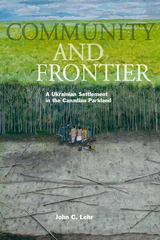 Community and Frontier: A Ukrainian Settlement in the Canadian Parkland
John C. Lehr
University of Manitoba Press, 2011 A social and economic history of one of the oldest Ukrainian settlements in Western Canada. Established in 1896, the Stuartburn colony was one of the earliest Ukrainian settlements in western Canada. Based on an analysis of government records, pioneer memoirs, and the Ukrainian and English language press, Community and Frontier is a detailed examination of the social, economic, and geographical challenges of this unique ethnic community. It reveals a complex web of inter-ethnic and colonial relationships that created a community that was a far cry from the homogeneous ethnic block settlement feared by the opponents of eastern European immigration. Instead, ethnic relationships and attitudes transplanted from Europe affected the development of trade within the colony, while Ukrainian religious factionalism and the predatory colonial attitudes of mainstream Canadian churches fractured the community and for decades contributed to social dysfunction.
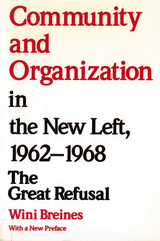 Community and Organization in the New Left, 1962-1968: The Great Refusal
Breines, Wini
Rutgers University Press, 1989 Did New Left activists have an opportunity to start a revolution that they simply could not bring off? Was their rejection of conventional forms of political organization a fatal flaw or were the apparent weaknesses of the movement -- the lack of central authority, the distrust of politics -- actually hidden strengths? Wini Breines traces the evolution of the New Left movement through the Free Speech Movement, Students for a Democratic Society (SDS), and SDS's community organization projects. For Breines, the movement's goal of participatory decision-making, even when it was not achieved, made up for its failure to take practical and direct action. By the late 1960s, antiwar activism contributed to the decline of the New Left, as the movement was flooded with new participants who did not share the founding generation's political experiences or values. Originally published in 1982, Wini Breines's classic work now includes a new preface in which she reassesses, and for the most part affirms, her initial views of the movement. She argues that the movement remains effective in the midst of radical changes in activist movements. Breines also summarizes and evaluates the new and growing scholarship on the 1960s. Her provocative analysis of the New Left remains important today.
Community and Progress in Kant's Moral Philosophy
Kate A. Moran
Catholic University of America Press, 2012 The text draws on a wide range of Immanuel Kant's writings, including his texts on moral and political philosophy and his lectures on ethics, pedagogy, and anthropology. Though the book is grounded in an analysis of Kant's writing, it also puts forward the novel claim that Kant's theory is centrally concerned with the relationships we have in our day-to-day lives.
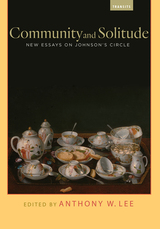 Community and Solitude: New Essays on Johnson’s Circle
Lee, Anthony W
Bucknell University Press, 2019 Samuel Johnson’s life was situated within a rich social and intellectual community of friendships—and antagonisms. Community and Solitude is a collection of ten essays that explore relationships between Johnson and several of his main contemporaries—including James Boswell, Edmund Burke, Frances Burney, Robert Chambers, Oliver Goldsmith, Bennet Langton, Arthur Murphy, Richard Savage, Anna Seward, and Thomas Warton—and analyzes some of the literary productions emanating from the pressures within those relationships. In their detailed and careful examination of particular works situated within complex social and personal contexts, the essays in this volume offer a “thick” and illuminating description of Johnson’s world that also engages with larger cultural and aesthetic issues, such as intertextuality, literary celebrity, narrative, the nature of criticism, race, slavery, and sensibility.
Contributors: Christopher Catanese, James Caudle, Marilyn Francus, Christine Jackson-Holzberg, Claudia Thomas Kairoff, Elizabeth Lambert, Anthony W. Lee, James E. May, John Radner, and Lance Wilcox.
Published by Bucknell University Press. Distributed worldwide by Rutgers University Press.
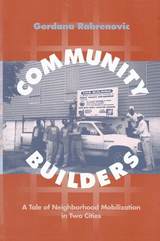 Community Builders
Gordana Rabrenovic
Temple University Press, 1996 In the 1980s the failure of corporate strategies and trickle-down economics led to gross inequalities among many U.S. neighborhoods and cities. By examining and comparing a gentrifying and a low-income neighborhood in two medium-sized cities, Gordana Rabrenovic shows how the problems they faced are typical of a number of neighborhoods nationwide. In particular, Rabrenovic focuses on the relationship between neighborhood associations and urban restructuring, arguing persuasively that the success of neighborhood associations depends more on the city in which the neighborhood is located than on the neighborhood itself.
Her tale discusses two very different cities with distinct political economies: Albany, a healthy service sector city, and Schenectady, a declining manufacturing city. Acknowledging both the value and limits of collective action, Rabrenovic addresses issues of particular relevance in urban areas, such as land use and crime, as well as the need for neighborhood organizations to forge links with local elites and other neighborhoods, and to engage and bring together poor and minority residents. Her analysis of neighborhood-based mobilization, preservation, and revitalization illuminates the ways in which grassroots issues intersect with prevailing political agendas and the national economy, as well as how issues such as race and class affect daily community politics.
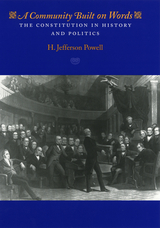 A Community Built on Words: The Constitution in History and Politics
H. Jefferson Powell
University of Chicago Press, 2002 H. Jefferson Powell offers a powerful new approach to one of the central issues in American constitutional thinking today: the problem of constitutional law's historicity, or the many ways in which constitutional arguments and outcomes are shaped both by historical circumstances and by the political goals and commitments of various actors, including judges. The presence of such influences is often considered highly problematic: if constitutional law is political and historical through and through, then what differentiates it from politics per se, and what gives it integrity and coherence? Powell argues that constitutional theory has as its (sometimes hidden) agenda the ambition of showing how constitutional law can escape from history and politics, while much constitutional history seeks to identify an historically true meaning of the constitutional text that, once uncovered, can serve as a corrective to subsequent deviations from that truth.
Combining history and theory, Powell analyzes a series of constitutional controversies from 1790 to 1944 to demonstrate that constitutional law from its very beginning has involved politically charged and ideologically divisive arguments. Nowhere in our past can one find the golden age of apolitical constitutional thinking that a great deal of contemporary scholarship seeks or presupposes. Viewed over time, American constitutional law is a history of political dispute couched in constitutional terms.
Powell then takes his conclusions one step further, claiming that it is precisely this historical tradition of argument that has given American constitutional law a remarkable coherence and integrity over time. No matter what the particular political disputes of the day might be, constitutional argument has provided a shared language through which our political community has been able to fight out its battles without ultimately fracturing.
A Community Built on Words will be must reading for any student of constitutional history, theory, or law.
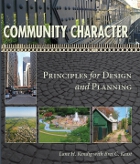 Community Character: Principles for Design and Planning
Lane H. Kendig with Bret C. Keast
Island Press, 2010 Community Character provides a design-oriented system for planning and zoning communities but accounts for how people who participate in a community live, work, and shop there. The relationships that Lane Kendig defines here reflect the complexity of the interaction of the built environment with its social and economic uses, taking into account the diverse desires of municipalities and citizens. Among the many classifications for a community’s “character” are its relationship to other communities, its size and the resulting social and economic characteristics.
According to Kendig, most comprehensive plans and zoning regulations are based entirely on density and land use, neither of which effectively or consistently measures character or quality of development. As Kendig shows, there is a wide range of measures that define character and these vary with the type of character a community desires to create. Taking a much more comprehensive view, this book offers “community character” as a real-world framework for planning for communities of all kinds and sizes.
A companion book, A Practical Guide to Planning with Community Character, provides a detailed explanation of applying community character in a comprehensive plan, with chapters on designing urban, sub-urban, and rural character types, using character in comprehensive plans, and strategies for addressing characteristic challenges of planning and zoning in the 21st century.
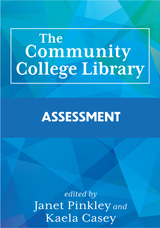 The Community College Library: Assessment
Janet Pinkley
American Library Association, 2022 Community colleges are a cornerstone of higher education and serve the unique needs of the communities in which they reside. In 2019, community colleges accounted for 41 percent of all undergraduate students in the United States.
Community college librarians are engaged in meaningful work designing and delivering library programs and services that meet the needs of their diverse populations and support student learning. The Community College Library series is meant to lift the voices of community college librarians and highlight their creativity, tenacity, and commitment to students.
The Community College Library: Assessment explores the research, comprehensive plans, and new approaches to assessment being created by community college librarians around the U.S. Chapters include sample activities and materials and cover topics including assessing student learning while shifting from Standards to Framework; investigating and communicating library instruction’s relationship to student retention; and building librarian assessment confidence through communities of research practice.
This book demonstrates the innovative and replicable ways community college librarians are measuring, evaluating, and reflecting on the services they provide, and how to use these assessments to demonstrate the value and impact of library services and advocate for resources.
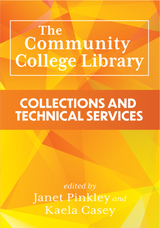 The Community College Library: Collections and Technical Services
Janet Pinkley
Association of College & Research Libraries, 2025 Community colleges are a cornerstone of higher education and serve the unique needs of the communities in which they reside. Collections and technical services librarians at these institutions need expertise in their area of library work, but also a deep understanding of the community they serve to curate and make discoverable the resources their users need.
The Community College Library: Collections and Technical Services highlights the various approaches to collection development and the technical services work being done by community college librarians around the U.S. You’ll find strategies for developing equity-centered collections, data-driven acquisitions, cataloging, systems migrations, zero textbook cost degrees, and more. These programs can serve as a model, providing new and innovative ways to approach this work at your own institutions.
Community college librarians are engaged in meaningful work designing and delivering library programs and services that meet the needs of their diverse populations and support student learning. ACRL’s “The Community College Library” series is meant to lift the voices of community college librarians and highlight their creativity, tenacity, and commitment to students.
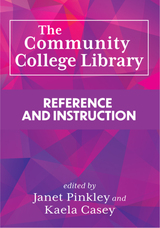 The Community College Library: Reference and Instruction
Janet Pinkley
American Library Association, 2022 Community colleges are a cornerstone of higher education and serve the unique needs of the communities in which they reside. In 2019, community colleges accounted for 41 percent of all undergraduate students in the United States.
Community college librarians are engaged in meaningful work designing and delivering library programs and services that meet the needs of their diverse populations and support student learning. The Community College Library series is meant to lift the voices of community college librarians and highlight their creativity, tenacity, and commitment to students.
The Community College Library: Reference and Instruction collects research, programs, and new approaches to reference and instruction implemented by community college librarians around the U.S. Chapters include sample activities and materials and cover topics including using race-centered and trauma-informed practices in the reference interview; incorporating online workshops into an existing information literacy program; and using student-driven pedagogy to navigate the early stages of research.
This book demonstrates the innovative and replicable ways community college librarians are meeting the information and research needs of their college population both in person and remotely, all while providing a safe, inclusive space for students to explore and learn.
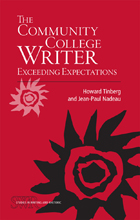 The Community College Writer: Exceeding Expectations
Howard Tinberg and Jean-Paul Nadeau
Southern Illinois University Press, 2010 While there have been several studies of writing programs at larger, baccalaureate institutions, the community college classroom has often been overlooked. Authors Howard Tinberg and Jean-Paul Nadeau fill this gap with The Community College Writer, a systematic and unique case study of first semester writing students at a community college. Drawing on surveys, interviews, and samples of classroom assignments, Tinberg and Nadeau use their research at one community college to reach out to instructors throughout the nation, fostering communication between community college faculty members in the effort to establish full-fledged writing programs geared toward student success. At the heart of the book are the voices of the students themselves, as they discuss both their teachers’ expectations and their own. Through a series of case studies, the authors reveal the challenges students face as budding writers, and their firsthand experiences with writing programs at the community college level. With this informative study, Tinberg and Nadeau seek not only to encourage dialogue between student and teacher or community college instructors, but to expand the conversation about program improvement to include both two- and four-year colleges, bringing composition faculty together in an effort to improve writing programs in all schools. Included in the volume are seven appendices, including surveys and interviews with faculty and students, making The Community College Writer a comprehensive and practical guide to tackling the issues facing writing programs and instructors.
 Community, Cosmopolitanism and the Problem of Human Commonality
Vered Amit and Nigel Rapport
Pluto Press, 2012 In this follow up to their widely read earlier volume, The Trouble with Community, Vered Amit and Nigel Rapport ask: 'Do notions of community remain central to our sense of who we are, in the dislocating context of globalization, or can we see beyond community closures to a human whole?'
This volume explores the variable nature of contemporary sociality. It focuses on the ethical, organizational and emotional claims and opportunities sought or fashioned for mobilizing and evading social collectivities in a world of mobile subjects. Here is an examination of the tensions and interactions between everyday forms of fluid fellowship, culturally normative claims to identity, and opportunities for realizing a universal humanity.
The book offers a new perspective on human commonality through a dialogue between two eminent anthropologists who come from distinct, but complementary positions.
Community Development: A Critical Approach, Second Edition
Margaret Ledwith
Bristol University Press, 2011 Community development finds itself in times of unprecedented political, social and economic change, locally and globally, at the same time as divisions between poverty and privilege widen. Building practical approaches to theory and theoretical approaches to practice, this updated and expanded second edition of a bestselling text develops critiques of the changing context and identifies challenges faced by community development both at community level and as a collective force for a more just, equal and sustainable future. Featuring a range of different models of community development and illustrative stories from practitioners in the field, the new edition will be essential reading for practitioners, students and educators involved in community development, youth and community work, social work, health and education.
Community Development in Action: Putting Freire into Practice
Margaret Ledwith
Bristol University Press, 2015 In a world in which social divisions are widening, not lessening, it is essential for proponents of community development—or of any other practice committed to social justice and sustainability—to understand how power works at every level, from grassroots projects to movements for change. Written with busy practitioners in mind, this exciting and practical book is filled to the brim with useful, practice-oriented ideas for reclaiming community development’s critical potential for social change. Building on the work of Paulo Freire, it presents theories in interesting and straightforward ways and will be an everyday reference for giving community development a critical edge.
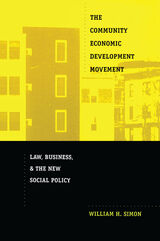 The Community Economic Development Movement: Law, Business, and the New Social Policy
William H. Simon
Duke University Press, 2001 While traditional welfare efforts have waned, a new style of social policy implementation has emerged dramatically in recent decades. The new style is reflected in a panoply of Community Economic Development (ced) initiatives—efforts led by locally-based organizations to develop housing, jobs, and business opportunities in low-income neighborhoods.
In this book William H. Simon provides the first comprehensive examination of the evolution of Community Economic Development, complete with an analysis of its operating premises and strategies. He describes the profusion of new institutional forms that have arisen from the movement, amalgamations that cut across conventional distinctions—such as those between private and public—and that encompass the efforts of nonprofits, cooperatives, churches, business corporations, and public agencies. Combining local political mobilization with entrepreneurial initiative and electoral accountability with market competition, this phenomenon has catalyzed new forms of property rights designed to motivate investment and civic participation while curbing the dangers of speculation and middle-class flight.
With its examination of many localities and its appraisal of the strengths and weaknesses of the prevailing approach to Community Economic Development, this book will be a valuable resource for local housing, job, and business development officials; community activists; and students of law, business, and social policy.
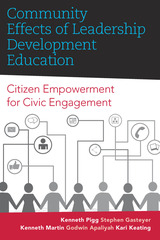 Community Effects of Leadership Development Education: Citizen Empowerment for Civic Engagement
Kenneth Pigg
West Virginia University Press, 2015 Community leadership development programs are designed to increase the capacity of citizens for civic engagement. These programs fill gaps in what people know about governance and the processes of governance, especially at the local level. The work of many in this field is a response to the recognition that in smaller, rural communities, disadvantaged neighborhoods, or disaster areas, the skills and aptitudes needed for citizens to be successful leaders are often missing or underdeveloped. Community Effects of Leadership Development Education presents the results of a five-year study tracking community-level effects of community leadership development programs drawn from research conducted in Illinois, Minnesota, Missouri, South Carolina, Ohio, and West Virginia. As the first book of its kind to seek answers to the question of whether or not the millions of dollars invested each year in community leadership development programs are valuable in the real world, this book challenges researchers, community organizers, and citizens to identify improved ways of demonstrating the link from program to implementation, as well as the way in which programs are conceived and designed. This text also explores how leadership development programs relate to civic engagement, power and empowerment, and community change, and it demonstrates that community leadership development programs really do produce community change. At the same time, the findings of this study strongly support a relational view of community leadership, as opposed to other traditional leadership models used for program design. To complement their findings, the authors have developed CENCE, a new model for community leadership development programs, which links leadership development efforts to community development by understanding how Civic Engagement, Networks, Commitment, and Empowerment work together to produce community viability.
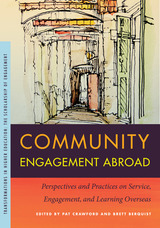 Community Engagement Abroad: Perspectives and Practices on Service, Engagement, and Learning Overseas
Pat Crawford
Michigan State University Press, 2020 A landmark in our understanding of international community-engaged learning programs, this book invites educators to rethink everything from disciplinary assumptions to the role of higher education in a globalizing world. Tapping the many such programs developed at Michigan State University during the last half-century, the volume develops a comprehensive framework for analyzing study-abroad programs with a community-engagement focus. More than a how-to guide, it also offers seven theoretically framed case studies showing how these experiences can change students, faculty, and communities alike. The purposeful broadening of who is involved in these types of international learning programs leads to conceptual transformation and self-reflection within the participants. The authors take the reader on a fascinating journey through how they changed as a result of designing and delivering programs in full collaboration with community partners. The arguments given in this volume for developing truly reciprocal, mutually beneficial partnerships beyond the academy are powerful and persuasive.
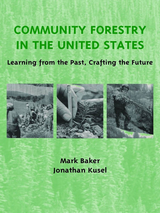 Community Forestry in the United States: Learning from the Past, Crafting the Future
Mark Baker and Jonathan Kusel
Island Press, 2003 Across the United States, people are developing new relationships with the forest ecosystems on which they depend, with a common goal of improving the health of the land and the well-being of their communities. Practitioners and supporters of what has come to be called community forestry are challenging current approaches to forest management as they seek to end the historical disfranchisement of communities and workers from forest management and the all-too-pervasive trends of long-term disinvestment in ecosystems and human communities that have undermined the health of both. Community Forestry in the United States is an analytically rigorous and historically informed assessment of this new movement. It examines the current state of community forestry through a grounded assessment of where it stands now and where it might go in the future. The book not only clarifies the state of the movement, but also suggests a trajectory and process for its continued development.
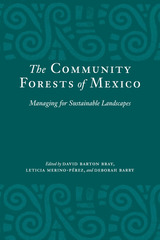 The Community Forests of Mexico: Managing for Sustainable Landscapes
Edited by David Barton Bray, Leticia Merino-Pérez, and Deborah Barry
University of Texas Press, 2005 Mexico leads the world in community management of forests for the commercial production of timber. Yet this success story is not widely known, even in Mexico, despite the fact that communities around the globe are increasingly involved in managing their own forest resources. To assess the achievements and shortcomings of Mexico's community forest management programs and to offer approaches that can be applied in other parts of the world, this book collects fourteen articles that explore community forest management from historical, policy, economic, ecological, sociological, and political perspectives. The contributors to this book are established researchers in the field, as well as many of the important actors in Mexico's nongovernmental organization sector. Some articles are case studies of community forest management programs in the states of Michoacán, Oaxaca, Durango, Quintana Roo, and Guerrero. Others provide broader historical and contemporary overviews of various aspects of community forest management. As a whole, this volume clearly establishes that the community forest sector in Mexico is large, diverse, and has achieved unusual maturity in doing what communities in the rest of the world are only beginning to explore: how to balance community income with forest conservation. In this process, Mexican communities are also managing for sustainable landscapes and livelihoods.
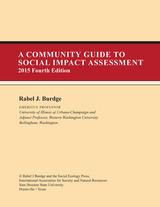 A Community Guide to Social Impact Assessment: Fourth Edition
Rabel J. Burdge
University Press of Colorado, 2018 The Guide is a tool for practitioners at all levels - social scientists, agency employees, community leaders, volunteers - to complete social impact assessments (SIAs) efficiently and effectively. The Guide is a how-to manual that provides the users with a step-by-step process easily followed by persons with minimal social science training. The Guide is organized into three sections: Chapters 1-6 provides the background, a short history, the conceptual model, the SIA scoping process and an explanation as to how to obtain data to measure SIA variables. Chapters 7-11 correspond to the five categories of SIA variables - population change, community and institutional arrangements, communities in transition, individual and family impacts and community infrastructure needs. Chapters 12-13 provide worksheets for summarizing SIA variables, and how resulting data may be used in the SIA mitigation/enhancement process.
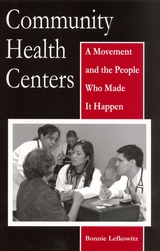 Community Health Centers: A Movement and the People Who Made It Happen
Lefkowitz, Bonnie
Rutgers University Press, 2007 The aftermath of Hurricane Katrina has placed a national spotlight on the shameful state of healthcare for America's poor. In the face of this highly publicized disaster, public health experts are more concerned than ever about persistent disparities that result from income and race.
This book tells the story of one groundbreaking approach to medicine that attacks the problem by focusing on the wellness of whole neighborhoods. Since their creation during the 1960s, community health centers have served the needs of the poor in the tenements of New York, the colonias of Texas, the working class neighborhoods of Boston, and the dirt farms of the South. As products of the civil rights movement, the early centers provided not only primary and preventive care, but also social and environmental services, economic development, and empowerment.
Bonnie Lefkowitz-herself a veteran of community health administration-explores the program's unlikely transformation from a small and beleaguered demonstration effort to a network of close to a thousand modern health care organizations serving nearly 15 million people. In a series of personal accounts and interviews with national leaders and dozens of health care workers, patients, and activists in five communities across the United States, she shows how health centers have endured despite cynicism and inertia, the vagaries of politics, and ongoing discrimination.
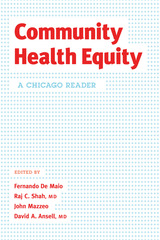 Community Health Equity: A Chicago Reader
Edited by Fernando De Maio, Raj C. Shah, MD, John Mazzeo, and David A. Ansell, MD
University of Chicago Press, 2019 Perhaps more than any other American city, Chicago has been a center for the study of both urban history and economic inequity. Community Health Equity assembles a century of research to show the range of effects that Chicago’s structural socioeconomic inequalities have had on patients and medical facilities alike. The work collected here makes clear that when a city is sharply divided by power, wealth, and race, the citizens who most need high-quality health care and social services have the greatest difficulty accessing them. Achieving good health is not simply a matter of making the right choices as an individual, the research demonstrates: it’s the product of large-scale political and economic forces. Understanding these forces, and what we can do to correct them, should be critical not only to doctors but to sociologists and students of the urban environment—and no city offers more inspiring examples for action to overcome social injustice in health than Chicago.
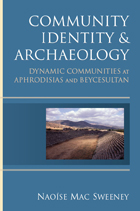 Community Identity and Archaeology: Dynamic Communities at Aphrodisias and Beycesultan
Naoíse Mac Sweeney
University of Michigan Press, 2011 Community Identity and Archaeology explores the concept of community identity and its application in archaeology, using the modern Turkish sites of Aphrodisias and Beycesultan as case studies to illustrate the formation and dissolution of communities over time. The concept of the community is vital to the way we understand human societies both past and present, and the last decade has seen widespread interest in communities from both the popular and academic spheres. The concept is also central to archaeology, where the relationship between sites and communities remains controversial. Naoíse Mac Sweeney aims to take the debate one step further, setting out a comprehensive framework for the archaeological investigation of community identity, encompassing theoretical approaches for its conceptualization, practical methodologies for its investigation, and detailed case studies in Anatolia to test and illustrate its arguments. This book contributes to discussions in archaeological theory and material culture studies and is particularly relevant to archaeologists working on different types of cultural identity. Community Identity and Archaeology’s readership will include undergraduate and graduate students as well as academic specialists. In addition, the book contains material of direct historical interest for Classics and Near Eastern departments. It includes valuable new research relevant for those working on Aegean, Mycenaean, or Early Greek antiquity, as well as specialists in Anatolia including scholars working on the Hittite, Phrygian, and Lydian empires.
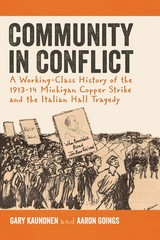 Community in Conflict: A Working-class History of the 1913-14 Michigan Copper Strike and the Italian Hall Tragedy
Gary Kaunonen
Michigan State University Press, 2013 A mirror of great changes that were occurring on the national labor rights scene, the 1913–14 Michigan Copper Strike was a time of unprecedented social upheaval in Michigan’s Upper Peninsula. With organized labor taking an aggressive stance against the excesses of unfettered capitalism, the stage was set for a major struggle between labor and management. The Michigan Copper Strike received national attention and garnered the support of luminaries in organized labor like Mother Jones, John Mitchell, Clarence Darrow, and Charles Moyer. The hope of victory was overshadowed, however, by violent incidents like the shooting of striking workers and their family members, and the bitterness of a community divided. No other event came to symbolize or memorialize the strike more than the Italian Hall tragedy, in which dozens of workers and working-class children died. In Community in Conflict, the efforts of working people to gain a voice on the job and in their community through their unions, and the efforts of employers to crush those unions, take center stage. Previously untapped historical sources such as labor spy reports, union newspapers, coded messages, and artifacts shine new light on this epic, and ultimately tragic, period in American labor history.
The Community in Rural America
Kenneth P. Wilkinson
University Press of Colorado, 2022 The Community in Rural America, by Kenneth P. Wilkinson, is a foundational theoretical work that both defines the interactional approach to the study of the community in rural areas and frames its application to encourage and promote rural community development. Recognized for its detailed theoretical construction and logic for understanding human interactions, this book has been widely adopted and used by researchers, extension faculty, and community development practitioners for over thirty years. Presenting Wilkinson’s groundbreaking work in its original form, with a new foreword aimed at clarifying several key concepts in interactional theory, this edition of The Community in Rural America will appeal to new students of the community as well as established scholars in the field.
 Community In-Between / Urur Dhex Dhexad Ah: Portraits of Somali-Americans in Columbus
Qorsho Hassan and Ruth M. Smith
Ohio State University Press, 2017 Community In-Between / Urur Dhex Dhexad Ah: Portraits of Somali-Americans in Columbus by Qorsho Hassan and Ruth M. Smith is a collection of stories and portraits of fifteen young Somali Americans involved in community building in Columbus, Ohio. By using their unique skills, these individuals balance their identities, build bridges, and create spaces for success. The rich, multifaceted stories in this book represent the heterogeneous experiences of the participants and show the deep connection to the diaspora and the interconnectedness of individual experiences.
A combination of storytelling and research connect each narrative to another, creating a strong framework for capturing the roles of young Somali Americans in community building through innovative initiatives such as designing a mixer bottle, beginning charitable programs, and educating the Somali community on voter rights. Two community artists help to capture the participants in their natural spaces, and their journey, aided by their empowering mentor, Riya Jama, bridges the gap of Somali females and their access to photography.
The portraits, stories, and artifacts throughout the book create a modicum of belonging. This new generation resiliently overcomes challenges such as racism, xenophobia, and Islamophobia while still maintaining their hope in the future. Community In-Between captures their spirit and unwavering faith.
The portraits, stories, and artifacts throughout the book create a modicum of belonging. This new generation resiliently overcomes challenges such as racism, xenophobia, and Islamophobia while still maintaining their hope in the future. Community In-Between captures their spirit and unwavering faith.
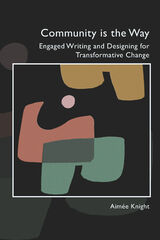 Community Is the Way: Engaged Writing and Designing for Transformative Change
by Aimée Knight
University Press of Colorado, 2022 How can we design for equity and justice in our community partnerships? This field guide offers a vision for enacting social justice with community partners. Working from a community’s resources and strengths toward the goal of building its internal capacity, this book considers how actions such as grassroots activism, decolonization efforts, co-resistance movements, and social change initiatives can support reciprocity and mutuality. Community is the Way provides examples of concrete, situated action grounded in disciplinary knowledge and extensive fieldwork. Reflecting on her experiences operating a community writing program, author Aimée Knight argues that the equity-based approach described in this book requires a commitment to interrogating how power, oppression, resistance, privilege, penalties, benefits, and harms are built into the systems we seek to change. Knight offers a community-led approach that builds bridges of understanding and support and charts a path toward transformative change.
 Community Is the Way: Engaged Writing and Designing for Transformative Change
by Aimée Knight
University Press of Colorado, 2022 How can we design for equity and justice in our community partnerships? This field guide offers a vision for enacting social justice with community partners. Working from a community’s resources and strengths toward the goal of building its internal capacity, this book considers how actions such as grassroots activism, decolonization efforts, co-resistance movements, and social change initiatives can support reciprocity and mutuality. Community is the Way provides examples of concrete, situated action grounded in disciplinary knowledge and extensive fieldwork. Reflecting on her experiences operating a community writing program, author Aimée Knight argues that the equity-based approach described in this book requires a commitment to interrogating how power, oppression, resistance, privilege, penalties, benefits, and harms are built into the systems we seek to change. Knight offers a community-led approach that builds bridges of understanding and support and charts a path toward transformative change.
Community Listening: Stories, Hauntings, Possibilities
Jenn Fishman
University Press of Colorado, 2025 Generating more questions than it answers, Community Listening invites readers to learn about listening that is deeply enmeshed in specific community sites, stories, and relations. Contributors bring their lived experience as listeners in, to, and alongside the communities whose praxes they surface in chapters that enrich and complicate the deep interrelationship of listening and storytelling. Affirming that storytelling is the vessel through which community listening is made, unmade, and remade, the stories in this collection probe what it means to listen from community vantages and to bring such listening into academic conversations. Collectively, the contributors to this multidisciplinary collection advance scholarship that has community as the locus of iterative knowledge seeking and sharing.
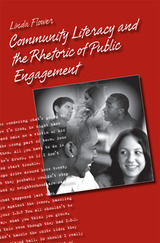 Community Literacy and the Rhetoric of Public Engagement
Linda Flower
Southern Illinois University Press, 2008 Community Literacy and the Rhetoric of Public Engagement explores the critical practice of intercultural inquiry and rhetorical problem-solving that encourages urban writers and college mentors alike to take literate action. Author Linda Flower documents an innovative experiment in community literacy, the Community Literacy Center in Pittsburgh, and posits a powerful and distinctively rhetorical model of community engagement and pedagogy for both marginalized and privileged writers and speakers. In addition, she articulates a theory of local publics and explores the transformative potential of alternative discourses and counter-public performances. In presenting a comprehensive pedagogy for literate action, the volume offers strategies for talking and collaborating across difference, forconducting an intercultural inquiry that draws out situated knowledge and rival interpretations of shared problems, and for writing and speaking to advocate for personal and public transformation. Flower describes the competing scripts for social engagement, empowerment, public deliberation, and agency that characterize the interdisciplinary debate over models of social engagement. Extending the Community Literacy Center’s initial vision of community literacy first published a decade ago, Community Literacy and the Rhetoric of Public Engagement makes an important contribution to theoretical conversations about the nature of the public sphere while providing practical instruction in how all people can speak publicly for values and visions of change.
Winner, 2009 Rhetoric Society of America Book Award
 Community Mental Health and Social Psychiatry: A Reference Guide
Harvard Medical School and Psychiatric Service, Massachusetts General Hospital; ,John Alexander Baldwin; Sidney Gelfand; and James Gordon Kelly
Harvard University Press This single source provides a manageable, representative selection of rapidly accumulating literature. 1,158 items, primarily in U.S. literature from January 1953 to April 1961, complement the 984 items to May 1953 of Evaluation in Mental Health (USPHS Publications, 413).
The Guide’s arrangement imposes a useful structure upon the entire field; the detailed subject index offers easy access to all aspects of the materials. Part I lists 15 books for orientation in the field. Part II gives 715 items in five subject-categories: theory; practice; research methods and findings; evaluations and reviews of practice and research; and professional roles. Part III lists 317 items for related professions, and social problems. Part IV gives 61 bibliographical items to aid access to more extensive or specialized materials and 22 reference books on vital statistics and census data. Part V lists 28 reference works on information and funding organizations, with their addresses. The Guide’s comprehensive Author-Title-Subject Index is of special value. Introductory discussions, instructions on use, and a List of Journals are included.
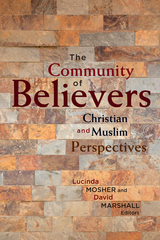 The Community of Believers: Christian and Muslim Perspectives
Lucinda Mosher and David Marshall, Editors
Georgetown University Press, 2015 The Community of Believers offers the proceedings of the 2013 Building Bridges seminar, a dialogue between leading Christian and Muslim scholars under the stewardship of Georgetown University. These essays consider such themes as the Church as mystical body of Christ versus the Church as proclamation; the roots and uses of the term ummah and its development over time; Christian desires for communion, experiences of division, and approaches to unity; the history of Muslim disunity; twentieth-century Christian ecclesiology and its responses to a post-Christendom and post-Christian world; and the Arab Spring as a case study for contemplating accommodationism, conservatism, reformism, and fundamentalism as Muslim strategies to address the pressures of modernism. The volume also includes texts and commentaries used in the seminar’s discussions of each topic and a concluding essay summarizing the tone, content, and style of participant exchanges throughout the seminar.
A Community of Character: Toward a Constructive Christian Social Ethic
Stanley Hauerwas
University of Notre Dame Press, 1981 Stanley Hauerwas, a leading theological ethicist, shows how discussions of Christology and the authority of scripture involve questions about what kind of community the church must be to rightly tell the stories of God. He challenges the dominant assumption of contemporary Christian social ethics that there is a special relation between Christianity and some form of liberal democratic social system.
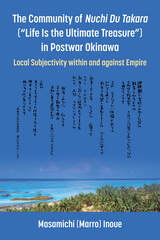 The Community of Nuchi Du Takara ("Life Is the Ultimate Treasure") in Postwar Okinawa: Local Subjectivity within and against Empire
Masamichi (Marro) Inoue
University of Michigan Press, 2025 Against the background of the prolonged US military presence in post–World War II Okinawa, The Community of Nuchi Du Takara (“Life Is the Ultimate Treasure”) in Postwar Okinawa explores the conflict between Okinawa and the US-Japan alliance. Developing the local notion of nuchi du takara into an analytical concept, Inoue examines how Okinawan activists, artists, writers, and other social actors have resisted US military presence, particularly the planned construction of a new military facility in northern Okinawa. The concept of nuchi du takara also helps Inoue explore complex negotiations Okinawa has had with Washington and Tokyo beyond resistance and protest, a process that involves developing a local communal capacity to embrace diverse and often contradictory attitudes toward the US military. Inoue’s grounded investigation underscores the possibility of small yet significant, incremental social changes from below, a possibility that ultimately points toward the World Republic—an international politics built upon peace, democracy, and shared affluence—against the sovereignty of global capitalism.
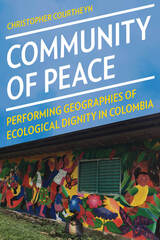 Community of Peace: Performing Geographies of Ecological Dignity in Colombia
Christopher Courtheyn
University of Pittsburgh Press, 2022 Achieving peace is often thought about in terms of military operations or state negotiations. Yet it also happens at the grassroots level, where communities envision and create peace on their own. The San José de Apartadó Peace Community of small-scale farmers has not waited for a top-down peace treaty. Instead, they have actively resisted forced displacement and co-optation by guerrillas, army soldiers, and paramilitaries for two decades in Colombia’s war-torn Urabá region. Based on ethnographic action research over a twelve-year period, Christopher Courtheyn illuminates the community’s understandings of peace and territorial practices against ongoing assassinations and displacement. San José’s peace through autonomy reflects an alternative to traditional modes of politics practiced through electoral representation and armed struggle. Courtheyn explores the meaning of peace and territory, while also interrogating the role of race in Colombia’s war and the relationship between memory and peace. Amid the widespread violence of today’s global crisis, Community of Peace illustrates San José’s rupture from the logics of colonialism and capitalism through the construction of political solidarity and communal peace.
The Community of Rights
Alan Gewirth
University of Chicago Press, 1997 Alan Gewirth extends his fundamental principle of equal and universal human rights, the Principle of Generic Consistency, into the arena of social and political philosophy, exploring its implications for both social and economic rights. He argues that the ethical requirements logically imposed on individual action hold equally for the supportive state as a community of rights, whose chief function is to maintain and promote the universal human rights to freedom and well-being. Such social afflictions as unemployment, homelessness, and poverty are basic violations of these rights, which the supportive state is required to overcome. A critical alternative to both "liberal" and "communitarian" views, this book will command the attention of anyone engaged in the debate over social and economic justice.
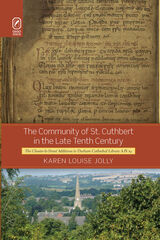 The Community of St. Cuthbert in the Late Tenth Century: The Chester-le-Street Additions to Durham Cathedral Library A.IV.19
Karen Louise Jolly
Ohio State University Press, 2012 The Community of St. Cuthbert in the Late Tenth Century: The Chester-le-Street Additions to Durham Cathedral Library A.IV.19 reveals the dynamic role a seemingly marginalized community played during a defining period for the emergence of English religious identity. Based on her new critical edition of additions made to Durham Cathedral Library A.IV.19 and by questioning the purpose of those late tenth-century additions, Karen Louise Jolly is able to uncover much about the Chester-le-Street scribes and their tumultuous time, rife as it was with various political tensions, from Vikings and local Northumbrian nobles to an increasingly dominant West Saxon monarchy.
Why, for instance, would a priest laboriously insert an Old English gloss above every Latin word in a collection of prayers intended to be performed in Latin? What motivated the same English scribe to include Irish-derived Christian materials in the manuscript, including prayers invoking the archangel Panchiel to clear birds from a field? Jolly’s extensive contextual analysis includes a biography of Aldred, the priest and provost of the community primarily responsible for adding these unusual texts. Besides reinterpreting the manuscript's paleography and codicology, she investigates both the drive for reform evidenced by the added liturgical materials and the new importance of Irish-derived encyclopedic and educational materials.
 The Community of the Renewed Covenant: The Notre Dame Symposium on the Dead Sea Scrolls
Eugene Ulrich
University of Notre Dame Press, 1996 The 13 Qumran scholars in this book present the most recent overviews and syntheses in various areas of scrolls study, making The Community of the Renewed Covenant the broadest, most authoritative, and up-to-date book available on the Dead Sea Scrolls. These essays provide descriptions of the major areas of research, as well as explore the implications for longstanding problems in the field.
"This is a first-rate collection of cutting-edge essays on an important and rapidly expanding area in religious studies and the humanities."-Choice
"The Community of the Renewed Covenant makes an important contribution to the study of the Dead Sea Scrolls. It contains clear and comprehensive studies about major topics connected with the Scrolls and it is written by many of today's main editors of Qumran texts. The essays describe the Qumran community and its tenets, and form a remarkable and up-to-date collection of studies."-Joseph A. Fitzmyer, S.J., Professor Emeritus, Biblical Studies, The Catholic University of America
----------
"This is a first-rate collection of cutting-edge essays on an important and rapidly expanding area in religious studies and the humanities." -Choice
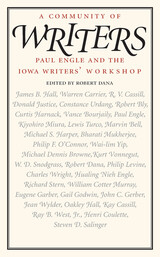 A Community of Writers: Paul Engle and the Iowa Writers' Workshop
Dana, Robert
University of Iowa Press, 1999 With these words, written long before his Iowa Writers' Workshop became world famous, much imitated, and academically rich, Paul Engle captured the spirit behind his beloved workshop. Now, in this collection of essays by and about those writers who shared the energetic early years, Robert Dana presents a dynamic, informative tribute to Engle and his world. The book's three sections mingle myth and history with style and grace and no small amount of humor. The beginning essays are given over to memories of Paul Engle in his heyday. The second group focuses particularly on those teachers—Robert Lowell, John Berryman, Kurt Vonnegut, for example—who made the workshop hum on a day-to-day basis. Finally, the third section is devoted to storytelling: tall tales, vignettes, surprises, sober and not-so-sober moments. Engle's own essay, "The Writer and the Place," describes his "simple, and yet how reckless" conviction that "the creative imagination in all of the arts is as important, as congenial, and as necessary, as the historical study of all the arts." Today, of course, there are hundreds of writers' workshops, many of them founded and directed by graduates of the original Iowa workshop. But when Paul Engle arrived in Iowa there were exactly two. His indomitable nature and great persuasive powers, combined with his distinguished reputation as a poet, loomed large behind the enhancement of the Iowa Writers' Workshop. This volume of fine and witty essays reveals the enthusiasm and drive and sheer pleasure that went into Iowa's renowned workshop.
Community Organizing
Minkler, Meredith
Rutgers University Press, 1997
As public health problems such as HIV/AIDS, substance abuse, violence, and environmental toxins become an ever greater part of our national landscape, grassroots public health work has become all the more important. This updated and revised edition of a highly praised volume provides meaningful insights into the systems of inequality in the United States—such as race, class, and gender—that impact health. Updated versions of a number of the original chapters, as well as new chapters and appendixes, address areas such as using community organizing to impact on policy; using the arts in community building and organizing; online activism; and the role of cultural humility and systems change in building effective partnerships between local health departments and community residents.
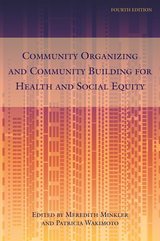 Community Organizing and Community Building for Health and Social Equity, 4th edition
Meredith Minkler and Patricia Wakimoto
Rutgers University Press, 2022 The fourth edition of Community Organizing and Community Building for Health and Social Equity provides both classic and recent contributions to the field, with a special accent on how these approaches can contribute to health and social equity. The 23 chapters offer conceptual frameworks, skill- building and case studies in areas like coalition building, organizing by and with women of color, community assessment, and the power of the arts, the Internet, social media, and policy and media advocacy in such work. The use of participatory evaluation and strategies and tips on fundraising for community organizing also are presented, as are the ethical challenges that can arise in this work, and helpful tools for anticipating and addressing them. Also included are study questions for use in the classroom. Many of the book’s contributors are leaders in their academic fields, from public health and social work, to community psychology and urban and regional planning, and to social and political science. One author was the 44th president of the United States, himself a former community organizer in Chicago, who reflects on his earlier vocation and its importance. Other contributors are inspiring community leaders whose work on-the-ground and in partnership with us “outsiders” highlights both the power of collaboration, and the cultural humility and other skills required to do it well. Throughout this book, and particularly in the case studies and examples shared, the role of context is critical, and never far from view. Included here most recently are the horrific and continuing toll of the COVID-19 pandemic, and a long overdue, yet still greatly circumscribed, “national reckoning with systemic racism,” in the aftermath of the brutal police killing of yet another unarmed Black person, and then another and another, seemingly without end. In many chapters, the authors highlight different facets of the Black Lives Matter movement that took on new life across the country and the world in response to these atrocities. In other chapters, the existential threat of climate change and grave threats to democracy also are underscored. View the Table of Contents and introductory text for the supplementary instructor resources. (https://d3tto5i5w9ogdd.cloudfront.net/wp-content/uploads/2022/02/04143046/9781978832176_optimized_sampler.pdf) Supplementary instructor resources are available on request: https://www.rutgersuniversitypress.org/communityorganizing
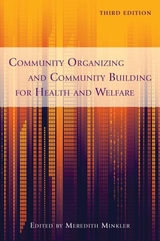 Community Organizing and Community Building for Health and Welfare
Edited by Meredith Minkler
Rutgers University Press, 2012
The third edition of Community Organizing and Community Building for Health and Welfare provides new and more established ways to approach community building and organizing, from collaborating with communities on assessment and issue selection to using the power of coalition building, media advocacy, and social media to enhance the effectiveness of such work.
With a strong emphasis on cultural relevance and humility, this collection offers a wealth of case studies in areas ranging from childhood obesity to immigrant worker rights to health care reform. A "tool kit" of appendixes includes guidelines for assessing coalition effectiveness, exercises for critical reflection on our own power and privilege, and training tools such as "policy bingo." From former organizer and now President Barack Obama to academics and professionals in the fields of public health, social work, urban planning, and community psychology, the book offers a comprehensive vision and on-the-ground examples of the many ways community building and organizing can help us address some of the most intractable health and social problems of our times.
Dr. Minkler's course syllabus: Although Dr. Minkler has changed the order of some chapters in the syllabus to accommodate guest speakers and help students prep for the midterm assignment she uses, she arranged the actual book layout in a way that should flow quite naturally if instructors wish to use it in the order in which chapters appear.
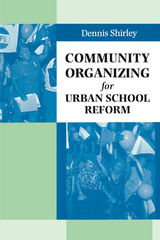 Community Organizing for Urban School Reform
By Dennis Shirley
University of Texas Press, 1997 Observers of all political persuasions agree that our urban schools are in a state of crisis. Yet most efforts at school reform treat schools as isolated institutions, disconnected from the communities in which they are embedded and insulated from the political realities which surround them. Community Organizing for Urban School Reform tells the story of a radically different approach to educational change. Using a case study approach, Dennis Shirley describes how working-class parents, public school teachers, clergy, social workers, business partners, and a host of other engaged citizens have worked to improve education in inner-city schools. Their combined efforts are linked through the community organizations of the Industrial Areas Foundation, which have developed a network of over seventy "Alliance Schools" in poor and working-class neighborhoods throughout Texas. This deeply democratic struggle for school reform contains important lessons for all of the nation's urban areas. It provides a striking point of contrast to orthodox models of change and places the political empowerment of low-income parents at the heart of genuine school improvement and civic renewal.
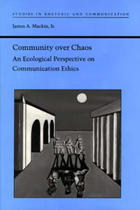 Community over Chaos: An Ecological Perspective on Communication Ethics
James A. Mackin
University of Alabama Press, 1997 This ecology of ethics seeks to balance the needs of the individual and those of the various levels of community. As James A. Mackin, Jr., shows, both modernism and postmodernism have undermined the traditional foundations for ethics. Using an ecological model, however, Community over Chaos develops a common ground for ethical judgments about communication, thus countering the current theoretical climate of pessimistic cynicism toward the very possibility of ethics. This theoretical pessimism is not merely an academic problem. The general public is becoming more and more disillusioned about the possibility of ethical communication. We are unable to teach principles of communicative ethics in our primary and secondary schools because we cannot agree on a common ground for those principles. Instead, we teach a narrow form of competence that is concerned primarily with short-term, individual success. Because our communities are built on our communicative practices, our inability to justify communicative ethics must ultimately lead to the disintegration of our communities. Mackin's ecological model assumes that each of us is a communicative system operating within larger communicative systems that together form our communicative ecosystem. Virtues of the ecological approach are practical wisdom, based in fuzzy logic, and communicative openness and honesty. Mackin recognizes the importance of both chaos and community in our communicative ecosystems. Chaos, as the source of originality and creativity, can contribute to growth and development; community provides the source of regularity and nurture that makes chaos endurable.
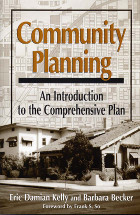 Community Planning: An Introduction To The Comprehensive Plan
Eric Damian Kelly and Barbara Becker; Foreword by Frank So
Island Press, 1999 This book introduces community planning as practiced in the United States, focusing on the comprehensive plan. Sometimes known by other names—especially master plan or general plan—the type of plan described here is the predominant form of general governmental planning in the U.S. Although many government agencies make plans for their own programs or facilities, the comprehensive plan is the only planning document that considers multiple programs and that accounts for activities on all land located within the planning area, including both public and private property. Written by a former president of the American Planning Association, Community Planning is thorough, specific, and timely. It addresses such important contemporary issues as sustainability, walkable communities, the role of urban design in public safety, changes in housing needs for a changing population, and multi-modal transportation planning. Unlike competing books, it addresses all of these topics in the context of the local comprehensive plan. There is a broad audience for this book: planning students, practicing planners, and individual citizens who want to better understand local planning and land use controls. Boxes at the end of each chapter explain how professional planners and individual citizens, respectively, typically engage the issues addressed in the chapter. For all readers, Community Planning provides a pragmatic view of the comprehensive plan, clearly explained by a respected authority.
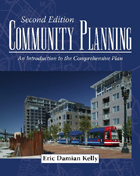 Community Planning: An Introduction to the Comprehensive Plan, Second Edition
By Eric Damian Kelly
Island Press, 2009 This book introduces community planning as practiced in the United States, focusing on the comprehensive plan. Sometimes known by other names—especially master plan or general plan—the type of plan described here is the predominant form of general governmental planning in the U.S. Although many government agencies make plans for their own programs or facilities, the comprehensive plan is the only planning document that considers multiple programs and that accounts for activities on all land located within the planning area, including both public and private property.
Written by a former president of the American Planning Association, Community Planning is thorough, specific, and timely. It addresses such important contemporary issues as sustainability, walkable communities, the role of urban design in public safety, changes in housing needs for a changing population, and multi-modal transportation planning. Unlike competing books, it addresses all of these topics in the context of the local comprehensive plan.
There is a broad audience for this book: planning students, practicing planners, and individual citizens who want to better understand local planning and land use controls. Boxes at the end of each chapter explain how professional planners and individual citizens, respectively, typically engage the issues addressed in the chapter. For all readers, Community Planning provides a pragmatic view of the comprehensive plan, clearly explained by a respected authority.
Community Planning in the 1920s: The Contribution of the Regional Planning Association of America
Roy Lubove
University of Pittsburgh Press, 1964 Roy Lubove presents the first detailed study of the Regional Planning Association of America, whose organization in 1923 signified a sharp break with traditional housing and planning in the United States. Composed of a small number of talented technicians and social critics, the RPAA was distinctive for its uncompromising criticism of small-scale speculative housing development and planning efforts that failed to relate physical and social change within a regional framework. Lubove's study is based in part upon interviews and materials supplied by some of the founding members of the RPAA.
COMMUNITY RECONSTRUCTS
James Campbell
University of Illinois Press, 1992 In The Community Reconstructs
James Campbell explores the Pragmatists' contributions to American social
thought, drawing upon the writings of William James, John Dewey, George Herbert
Mead, James Hayden Tufts, and their various critics. He explores the Pragmatic
analysis of society's potential for ongoing intelligent inquiry and cooperative
evaluation to address social ills. Campbell also considers the nature of political
language, the relative importance of the moral and political values of liberty
and equality, and the vital role of commitment to the life of a democratic community.
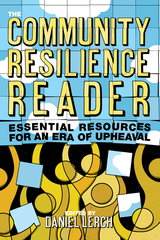 The Community Resilience Reader: Essential Resources for an Era of Upheaval
Edited by Daniel Lerch
Island Press, 2017 The sustainability challenges of yesterday have become today’s resilience crises. National and global efforts have failed to stop climate change, transition from fossil fuels, and reduce inequality. We must now confront these and other increasingly complex problems by building resilience at the community level. But what does that mean in practice, and how can it be done in a way that’s effective and equitable?
The Community Resilience Reader offers a new vision for creating resilience, through essays by leaders in such varied fields as science, policy, community building, and urban design. The Community Resilience Reader combines a fresh look at the challenges humanity faces in the 21st century, the essential tools of resilience science, and the wisdom of activists, scholars, and analysts working with community issues on the ground. It shows that resilience is a process, not a goal; how resilience requires learning to adapt but also preparing to transform; and that resilience starts and ends with the people living in a community. Despite the formidable challenges we face, The Community Resilience Reader shows that building strength and resilience at the community level is not only crucial, but possible.
From Post Carbon Institute, the producers of the award-winning The Post Carbon Reader, The Community Resilience Reader is a valuable resource for students, community leaders, and concerned citizens.
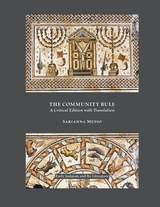 The Community Rule: A Critical Edition with Translation
Sarianna Metso
SBL Press, 2019 An authoritative critical edition
The discovery and translation of the Dead Sea Scrolls transformed our understanding of the life and history of ancient Jewish communities when both rabbinic Judaism and early Christianity were emerging. As part of this rich discovery, the Community Rule serves to illuminate the religious beliefs and practices as well as the organizational rules of the group behind the Dead Sea Scrolls. However, there is no single, unified text of the Community Rule; rather, multiple manuscripts of the Community Rule show considerable variation and highlight the work of ancient Jewish scribes and their intentional literary development of the text. In this volume, Sarianna Metso brings together the surviving evidence in a new edition that presents a critically established Hebrew text with an introduction and an English translation.
Features:
- A critical apparatus and textual notes
- All the surviving evidence of the Community Rule
- A new method for presenting complex developments and transmission history of ancient texts
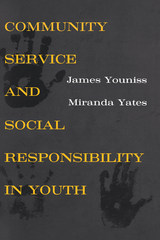 Community Service and Social Responsibility in Youth
James Youniss and Miranda Yates
University of Chicago Press, 1997 James Youniss and Miranda Yates present a sophisticated analysis of community service's beneficial effects on adolescents' political and moral identity.
Using a case study from a predominantly Black, urban high school in Washington, D.C., Youniss and Yates build on the insights of Erik Erikson on the social and historical nature of identity development. They show that service at a soup kitchen as part of a course on social justice gives youth the opportunity to reflect on their status in society, on how society is organized, on how government should use its power, and on moral principles related to homelessness and poverty. Developing a sense of social responsibility and a civic commitment, youth come to see themselves as active agents in society.
The most authoritative work to date on the subject, this book challenges negative stereotypes of contemporary adolescents and illustrates how youth, when given the opportunity, can use their talents for social good. It will interest readers concerned with the development of today's youth and tomorrow's society.
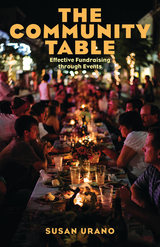 The Community Table: Effective Fundraising through Events
Susan Cole Urano
Ohio University Press, 2016 In resource-challenged Athens County, Ohio, staff and volunteers at the nonprofit Athens County Foundation came up with a daring idea: to host a locally sourced, gourmet dinner for four hundred people. The meal would be held on the brick-paved main street of the city of Athens, to raise funds for the food bank, and increase awareness of the persistent local struggle with food insecurity, as well as raise the visibility of the foundation. The logistical challenges were daunting, but the plan would unite the community around the common theme of providing for its own. Since then, Bounty on the Bricks has become a touchstone event that raises close to one hundred thousand dollars for the food bank. In The Community Table, Athens County Foundation executive director Susan Urano translates her years of nonprofit experience with large-scale annual fundraisers into a step-by-step guide for development professionals, community leaders, and volunteers. Urano guides readers to consider when to mount a fundraiser, who the stakeholders are, what social and financial value the event will bring to the community, and how partnerships might augment the payoff. Using real-life examples, she explains how organizers can learn from mistakes and illustrates methods of team building, conflict resolution, and problem solving. Sample ideas, timelines, budgets, publicity plans, and committee structures round out The Community Table.
A Community Transplanted: The Trans-Atlantic Experience of a Swedish Immigrant Settlement in the Upper Middle West, 1835-1915
Robert C. Ostergren
University of Wisconsin Press, 1988 "An exceptional work, meticulously researched and woven together with analytic rigor and attention to the particularities of the subject matter. It is written in a style that combines individual narrative histories with systematic empirical inquiry yielding a work that is intellectually sophisticated and at times lyrical. In short, it should not only be read by students of American immigration, but should serve as a model for future research."—International Migration Review
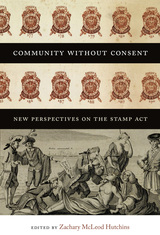 Community without Consent: New Perspectives on the Stamp Act
Edited by Zachary McLeod Hutchins
Dartmouth College Press, 2016 The first book-length study of the Stamp Act in decades, this timely collection draws together essays from a broad range of disciplines to provide a thoroughly original investigation of the influence of 1760s British tax legislation on colonial culture, and vice versa. While earlier scholarship has largely focused on the political origins and legacy of the Stamp Act, this volume illuminates the social and cultural impact of a legislative crisis that would end in revolution. Importantly, these essays question the traditional nationalist narrative of Stamp Act scholarship, offering a variety of counter identities and perspectives. Community without Consent recovers the stories of individuals often ignored or overlooked in existing scholarship, including women, Native Americans, and enslaved African Americans, by drawing on sources unavailable to or unexamined by earlier researchers. This urgent and original collection will appeal to the broadest of interdisciplinary audiences.
Community Without Unity: A Politics of Derridian Extravagance
William Corlett
Duke University Press, 1989 Winner of the 1990 Foundations of Political Theory Section of the American Political Science Association "First Book Award" Now available in paperback with a new preface by the author, this award-winning book breaks new ground by challenging traditional concepts of community in political theory. William Corlett brings the diverse (and sometimes contradictory) work of Foucault and Derrida to bear on the thought of Pocock, Burke, Lincoln, and McIntyre, among others, to move beyond the conventional dichotomy of "individual vs. community," arguing instead that community is best advanced within a politics of difference.
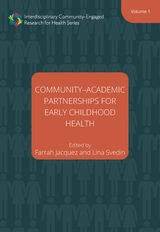 Community-Academic Partnerships for Early Childhood Health
Edited by Farrah Jacquez and Lina Svedin
University of Minnesota Press, 2019 Community-Academic Partnerships for Early Childhood Health is the first volume in the Interdisciplinary Community-Engaged Research for Health series. In this first volume, series editors Farrah Jacquez and Lina Svedin have invited academics around the country who participated in the first cohort of the Robert Wood Johnson Foundation’s (RWJ) prestigious, innovative Interdisciplinary Research Leaders (IRL) program to share results from their efforts. These three-person teams composed of two researchers and one community partner used applied research to create measurable change in healthcare and health outcomes for young children. Spanning disciplines from public health, psychology, policy, economics, medicine, nutrition and geography, academics teamed up with community partners, including medical practitioners, nonprofit leaders, and policymakers to create action and community benefit through research, intervention, and policy development. From research on the nonmedical needs of women in the Mississippi Delta, WIC programs in Puerto Rico, and children’s advocacy in Cincinnati, Ohio, the contributors describe seven cases depicting useful stepping stones for academic and community partners to collaborate and create a culture of health in the United States.
 Community-Based Language Learning: A Framework for Educators
Joan Clifford and Deborah S. Reisinger
Georgetown University Press, 2019 Community-based Language Learning offers a new framework for world language educators interested in integrating community-based language learning (CBLL) into their teaching and curricula. CBLL connects academic learning objectives with experiential learning, ranging from reciprocal partnerships with the community (e.g., community engagement, service learning) to one-directional learning situations such as community service and site visits. This resource prepares teachers to implement CBLL by offering solid theoretical frameworks alongside real-world case studies and engaging exercises, all designed to help students build both language skills and authentic relationships as they engage with world language communities in the US. Making the case that language learning can be a tool for social change as well, Community-based Language Learning serves as a valuable resource for language educators at all levels, as well as students of language teaching methodology and community organizations working with immigrant populations.
Community-Based Monitoring in the Arctic
Finn Danielsen, Noor Johnson, Olivia Lee, Maryann Fidel, Lisbeth Iversen, Michael K. Poulsen, Hajo Eicken, Ania Albin, Simone G. Hansen, Peter L. Pulsifer, Peter Thorne, and Martin Enghoff
University of Alaska Press, 2020 Community Based Monitoring Programs in the Arctic explores the concept and use of community-based monitoring (CBM) of ecological conditions in the Arctic. The authors analyze current programs and determines that CBM, while widespread and effective, nonetheless still has untapped potential. Presenting numerous examples and substantial data from a pan-Arctic survey and several workshops around the Arctic, Ths book offers a state of the field and a guide for mapping out the next steps.
Contributors include Finn Danielsen, Noor Johnson, Olivia Lee, Maryann Fidel, Lisbeth Iversen, Michael K. Poulsen, Hajo Eicken, Ania Albin, Simone G. Hansen, Peter L. Pulsifer, Peter Thorne, and Martin Enghoff.
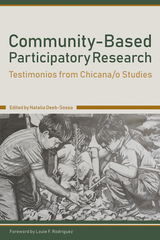 Community-Based Participatory Research: Testimonios from Chicana/o Studies
Edited by Natalia Deeb-Sossa; Foreword by Louie F. Rodriguez
University of Arizona Press, 2019 Members of communities of color in the United States often struggle for equity, autonomy, survival, and justice. Community-Based Participatory Research is an edited volume from activist-scholars who present personal testimonies showcasing how community-based participatory research (CBPR) can lead to sustainable change and empowerment. Editor Natalia Deeb-Sossa has chosen contributors whose diverse interdisciplinary projects are grounded in politically engaged research in Chicanx and Latinx communities. The scholars’ advocacy work is a core component of the research design of their studies, challenging the idea that research needs to be neutral or unbiased.
The testimonies tell of projects that stem from community demands for truly collaborative research addressing locally identified issues and promoting community social change. Contributors share their personal experiences in conducting CBPR, focusing on the complexities of implementing this method and how it may create sustainable change and community empowerment. Along with a retrospective analysis of how CBPR has been at the center of the Chicana/o Movement and Chicana/o studies, the book includes a discussion of consejos y advertencias (advice and warnings).
The most knowledgeable people on community issues are the very members of the communities themselves. Recognizing a need to identify the experiences and voices (testimonios) of communities of color, activist-scholars showcase how to incorporate the perspectives of the true experts: the poor, women, farmworkers, students, activists, elders, and immigrants.
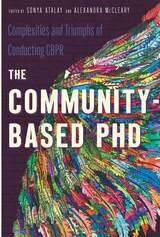 The Community-Based PhD: Complexities and Triumphs of Conducting CBPR
Edited by Sonya Atalay and Alexandra McCleary
University of Arizona Press, 2022 Community-based participatory research (CBPR) presents unique ethical and practical challenges, particularly for graduate students. This volume explores the nuanced experience of conducting CBPR as a PhD student. It explains the essential roles of developing trust and community relationships, the uncertainty in timing and direction of CBPR projects that give decision-making authority to communities, and the politics and ethical quandaries when deploying CBPR approaches—both for communities and for graduate students.
The Community-Based PhD brings together the experiences of PhD students from a range of disciplines discussing CBPR in the arts, humanities, social sciences, public health, and STEM fields. They write honestly about what worked, what didn’t, and what they learned. Essays address the impacts of extended research time frames, why specialized skill sets may be needed to develop community-driven research priorities, the value of effective relationship building with community partners, and how to understand and navigate inter- and intra-community politics.
This volume provides frameworks for approaching dilemmas that graduate student CBPR researchers face. They discuss their mistakes, document their successes, and also share painful failures and missteps, viewing them as valuable opportunities for learning and pushing the field forward. Several chapters are co-authored by community partners and provide insights from diverse community perspectives. The Community-Based PhD is essential reading for graduate students, scholars, and the faculty who mentor them in a way that truly crosses disciplinary boundaries.
Contributors: Anna S. Antoniou, Amy Argenal, Sonya Atalay, Stacey Michelle Chimimba Ault, Victoria Bochniak, Megan Butler, Elias Capello, Ashley Collier-Oxandale, Samantha Cornelius, Annie Danis, Earl Davis, John Doyle, Margaret J. Eggers, Cyndy Margarita García-Weyandt, R. Neil Greene, D. Kalani Heinz, Nicole Kaechele, Myra J. Lefthand, Emily Jean Leischner, Christopher B. Lowman, Geraldine Low-Sabado, Alexandra G. Martin, Christine Martin, Alexandra McCleary, Chelsea Meloche, Bonnie Newsom, Katherine L. Nichols, Claire Novotny, Nunanta (Iris Siwallace), Reidunn H. Nygård, Francesco Ripanti, Elena Sesma, Eric Simons, Cassie Lynn Smith, Tanupreet Suri, Emery Three Irons, Arianna Trott, Cecilia I. Vasquez, Kelly D. Wiltshire, Julie Woods, Sara L. Young
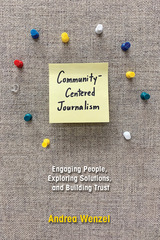 Community-Centered Journalism: Engaging People, Exploring Solutions, and Building Trust
Andrea Wenzel
University of Illinois Press, 2020 Contemporary journalism faces a crisis of trust that threatens the institution and may imperil democracy itself. Critics and experts see a renewed commitment to local journalism as one solution. But a lasting restoration of public trust requires a different kind of local journalism than is often imagined, one that engages with and shares power among all sectors of a community. Andrea Wenzel models new practices of community-centered journalism that build trust across boundaries of politics, race, and class, and prioritize solutions while engaging the full range of local stakeholders. Informed by case studies from rural, suburban, and urban settings, Wenzel's blueprint reshapes journalism norms and creates vigorous storytelling networks between all parts of a community. Envisioning a portable, rather than scalable, process, Wenzel proposes a community-centered journalism that, once implemented, will strengthen lines of local communication, reinvigorate civic participation, and forge a trusting partnership between media and the people they cover.
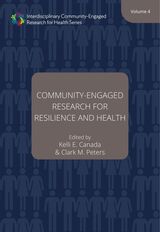 Community-Engaged Research for Resilience and Health, Volume 4
Edited by Kelli E. Canada and Clark M. Peters
University of Minnesota Press, 2022 Promoting resilience in underserved populations.
The fourth volume in the Interdisciplinary Community-Engaged Research for Health series departs from the traditional view of resilience driven by individuals and reconstructs it to hinge on the community of context. Editors Kelli E. Canada and Clark Peters identified six scholar-practitioner teams who worked to promote resilience in communities across the nation facing health crises and other structural barriers to health, such as low socioeconomic positions, structural racism, and discrimination. This research is part of a two-pronged approach to public health, intending to increase resilience and communities’ internal support while simultaneously reducing barriers to health care access.
The efforts featured in Community-Engaged Research for Resilience and Health highlight community-based solutions, points of strength, and sources of resilience to help communities that are struggling to survive and thrive in the face of adversity. Whether these communities are facing opioid addiction or other substance abuse issues, domestic violence, armed conflict, trauma, or cultural discrimination, the editors and contributors in this volume share examples of Community-Based Participatory Research (CBPR) practices where through a collaborative partnership, the community actively participates in every aspect of the alongside the interdisciplinary research team. What transpires demonstrates how researchers and communities come together to turn adversity into improved health through resilience-focused programs and interventions.
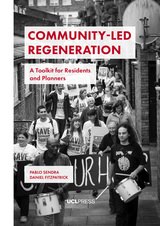 Community-Led Regeneration: A Toolkit for Residents and Planners
Pablo Sendra and Daniel Fitzpatrick
University College London, 2020 community-led plans, Community-Led Regeneration offers a toolkit of planning mechanisms and other strategies that residents and planners working with communities can use to resist demolition and propose community-led schemes. The case studies represent a broad overview of groups that formed as a reaction to proposed demolitions of residents' housing, and groups that formed as a way to manage residents' homes and public space better. Drawing from the case studies, the toolkit includes the use of formal planning instruments, as well as other strategies such as sustained campaigning and activism, forms of citizen-led design, and alternative proposals for the management and ownership of housing by communities themselves. Community-Led Regeneration targets a diverse audience: from planning professionals and scholars working with communities, to housing activists and residents resisting the demolition of their neighborhoods and proposing their own plans.
Commutative Semigroup Rings
Robert Gilmer
University of Chicago Press, 1984 Commutative Semigroup Rings was the first exposition of the basic properties of semigroup rings. Gilmer concentrates on the interplay between semigroups and rings, thereby illuminating both of these important concepts in modern algebra.
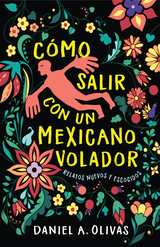 Cómo Salir con un Mexicano Volador: Relatos Nuevos y Escogidos
Daniel A. Olivas
University of Nevada Press, 2023 Cómo Salir con un Mexicano Volador es una colección de relatos derivados de las culturas Chicana y Mexicana, pero que abarca fascinantes mundos literarios de realismo mágico, cuentos de hadas, fábulas, y futuros fracturados. Los personajes se enfrentan—tanto directa como indirectamente—a cuestiones de moralidad, justicia, y autodeterminación.
La colección se compone de los relatos favoritos de Daniel A. Olivas, previamente publicados, junto con dos nuevos relatos, uno distópico y otro mítico, que desafían la retórica y las políticas anti-inmigración de la administración Trump. Los lectores se encontrarán con un mundo lleno tanto de lo mágico como de lo cotidiano: un hombre con doce dedos que se encuentra a sí mismo en una cita mística con una mujer; Dios, que se aparece en forma de gallina raquítica; una mujer que lucha con valentía contra su maltratador; y dioses aztecas en busca de relevancia tras la conquista española—solo por nombrar algunos de los singulares personajes que pueblan estas páginas. El libro reúne algunos de los cuentos más extraños e inolvidables de Olivas, permitiendo a los lectores experimentar su muy distintiva, y muy Chicana, ficción.
 Co-Motion: Re-Thinking Power, Subjects, and Feminist and Queer Alliances
Paola Bacchetta
Duke University Press, 2026 In Co-Motion, theorist Paola Bacchetta proposes a new lexicon for analyzing power, subjects and alliances. Employing what she calls ‘theory-assemblages’ to describe how diverse theoretical and political approaches inspire movements and produce different kinds of alliances, Bacchetta engages the inseparability of power relations—such as colonialism, capitalism, racism, caste, misogyny, and speciesism—and how their combinations, operability, and the analyses required, shift in different contexts and lives of subjects. Focusing on France, India, Italy, and the US from the 1970s to the present, Co-Motion addresses a wide activist, artivist, and social movement archive— group statements, banners, pamphlets, graffiti, posters, poetry, sit-ins, films, art exhibits—to think and feel with the many ways that people, historically and today, come together to act. Through her expansive engagement with varied bodies of scholarship, sites of analysis, and kinds of reading, Bacchetta offers new approaches for analyzing, confronting and transforming power, and enacting freedom.
 Compact Copyright: Quick Answers to Common Questions
Sara R. Benson
American Library Association, 2021 Included in Choice's Top 75 Titles and Resources for Community College Libraries Faculty, students, and colleagues come to you with copyright questions, both simple and complex. And they all want reliable answers—as fast as you can get them. With this guide, designed for ready access, you’ll be prepared to deliver. Lawyer, copyright librarian, and iSchool instructor Benson presents succinct explanations ideal for both on-the-fly reference and staff training. Copyright specialists will appreciate excerpts from the law itself alongside tools and resources for digging deeper. Practical discussions of key legal concepts, illustrated using 52 scenarios, will lead you to fast, accurate answers on a range of topics, such as - barriers to using the TEACH Act provisions in content for online teaching;
- showing a full-length movie in a university class;
- public domain and the 1998 Sonny Bono Copyright Term Extension Act;
- your legal options when receiving a DMCA take-down notice;
- court interpretations of fair use in three key recent cases;
- Creative Commons licenses, complete with a quick reference chart;
- library rights to license photographs in a digital collection;
- using letters under copyright in a special collections display case;
- a grad student’s right to use in a thesis writing published in their professor’s journal article;
- applying the implied license option to post historical student dissertations in institutional repositories;
- the Marrakesh Treaty provision supporting transfer of accessible works internationally; and
- limiting factors for interlibrary loan.
Compadre Colonialism: Studies in the Philippines under American Rule
Norman G. Owen, Editor
University of Michigan Press, 1971 This volume is a manifestation of the continuing interest of scholars at the University of Michigan in Philippine studies. Written by a generation of post-colonial scholars, it attempts to unravel some of the historical problems of the colonial era. Again and again the authors focus on the relationship of the ilustrados and the Americans, on the problems of continuity and discontinuity, and on the meaning of “modernization” in the Philippine context. As part of the Vietnam generation, these authors have looked at American imperialism with a new perspective, and yet their analysis is tempered, not strident, and reflective, not dogmatic. Perhaps the most central theme to emerge is the depth of the contradiction inherent in the American colonial experiment. [vi-vii]
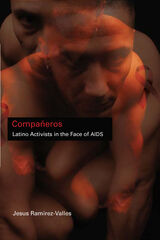 Compañeros: Latino Activists in the Face of AIDS
Jesus Ramirez-Valles
University of Illinois Press, 2011 Telling the affecting stories of eighty gay, bisexual, and transgender (GBT) Latino activists and volunteers living in Chicago and San Francisco, Compañeros: Latino Activists in the Face of AIDS closely details how these individuals have been touched or transformed by the AIDS epidemic. Weaving together activists' responses to oppression and stigma, their encounters with AIDS, and their experiences as GBTs and Latinos in North America and Latin America, Jesus Ramirez-Valles explores the intersection of civic involvement with ethnic and sexual identity. Even as activists battle multiple sources of oppression, they are able to restore their sense of family connection and self-esteem through the creation of an alternative space in which community members find value in their relationships with one another. In demonstrating the transformative effects of a nurturing community environment for GBT Latinos affected by the AIDS epidemic, Ramirez-Valles illustrates that members find support in one another, as compañeros, in their struggles with homophobia, gender discrimination, racism, poverty, and forced migration.
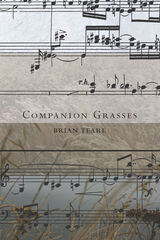 Companion Grasses
Brian Teare
Omnidawn, 2013 What does it mean to dwell in a place? These adventurous poems go on foot in search of answers. Walking the cities, coasts, forests and mountains of Northern California and New England, they immerse themselves in the specifics of bioregion and microclimate, and take special note of the cycle of death and rebirth that plays out dramatically in California’s chaparral and grasslands. Inspired by Transcendentalism, Companion Grasses sees the sacred in the workings of the material world, but its indebtedness to the ecological tradition of California poets like Gary Snyder and Brenda Hillman means that it also unearths such evidence in the sensual materiality of words themselves. Both ecologically rich landscapes and highly rhythmic inscapes, these poems set seasonal and human dramas side-by-side, wresting an original, signature music from the meeting of site and sight. In pursuing an aesthetics situated in place, they compose an ethics of what it means to be a human companion to the natural world: “What we love, how we care for it,/is where we live.”
The Companion Species Manifesto: Dogs, People, and Significant Otherness
Donna J. Haraway
Prickly Paradigm Press, 2003 The Companion Species Manifesto is about the implosion of nature and culture in the joint lives of dogs and people, who are bonded in "significant otherness." In all their historical complexity, Donna Haraway tells us, dogs matter. They are not just surrogates for theory, she says; they are not here just to think with. Neither are they just an alibi for other themes; dogs are fleshly material-semiotic presences in the body of technoscience. They are here to live with. Partners in the crime of human evolution, they are in the garden from the get-go, wily as Coyote. This pamphlet is Haraway's answer to her own Cyborg Manifesto, where the slogan for living on the edge of global war has to be not just "cyborgs for earthly survival" but also, in a more doggish idiom, "shut up and train."
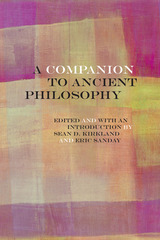 A Companion to Ancient Philosophy
Edited and with an introduction by Sean D. Kirkland and Eric Sanday
Northwestern University Press, 2018 A Companion to Ancient Philosophy is a collection of essays on a broad range of themes and figures spanning the entire period extending from the Pre-Socratics to Plato, Aristotle, and the Hellenistic thinkers.
Rather than offering synoptic and summary treatments of preestablished positions and themes, these essays engage with the ancient texts directly, focusing attention on concepts that emerge as urgent in the readings themselves and then clarifying those concepts interpretively. Indeed, this is a companion volume that takes a very serious and considered approach to its designated task—accompanying readers as they move through the most crucial passages of the infinitely rich and compelling texts of the ancients. Each essay provides a tutorial in close reading and careful interpretation.
Because it offers foundational treatments of the most important works of ancient philosophy and because it, precisely by doing so, arrives at numerous original interpretive insights and suggests new directions for research in ancient philosophy, this volume should be of great value both to students just starting off reading the ancients and to established scholars still fascinated by philosophy's deepest abiding questions.
 A Companion to Apollonius of Rhodes
Ruth Scodel
University of Michigan Press, 2025 This volume presents a companion text to ancient Greek poet Apollonius of Rhodes, author of the epic poem Argonautica, which stands on a level of importance with other major ancient epics like the Aeneid or the Odyssey. Ruth Scodel and her contributors examine Apollonius’ work from three points of view—his literary influences and impact on contemporary writers, the actual work of Apollonius, and his later reception in Latin. This companion volume seeks to help readers with varied reasons to be interested in Apollonius—whether they are interested in Latin poets whom he influenced, or in patronage, or narrative method.
A Companion to Apollonius of Rhodes aims to help contemporary readers appreciate what is most characteristic of Apollonius’ epic—its fascination with ritual and myth, gods who act without the direction of Zeus, frequent distanced narration, the portrayal of characters in situations where there are no good choices. It includes thorough analyses of the poem’s relationship to contemporary art with illustrations and treats familiar topics, such as Jason’s leadership, with nuance. Contributors include Benjamin Acosta-Hughes, Annemarie Ambühl, Anja Bettenworth, Keyne Cheshire, Christopher Chinn, James Clauss, Adele Teresa Cozzoli, Kristopher Fletcher, Alexander Hollmann, Regina Höschele, Niklas Holzberg, Alison Keith, Adolf Köhnken†, Anatole Mori, William H. Race, Norman Sandridge, Selina Stewart, Stefanie Stürner, and Graham Zanker.
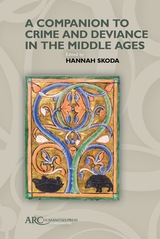 A Companion to Crime and Deviance in the Middle Ages
Hannah Skoda
Arc Humanities Press, 2023
This reference work examines the ways in which some medieval behaviours and identities were categorized as criminal or deviant. It also explores the implications of modern demonization of the Middle Ages. As well as discussing constructions of deviance, this book also explores the behaviours and identities which provoked these labels and processes. The model is one of reciprocity between behaviours and processes of demonisation and criminalisation. Each authoritative essay engages carefully with this approach, examining behaviours, the ways they were demonized, and the relationship between the two processes. The three parts of the volume are centred around forms of discursive and normative power—religious ideologies, political ideologies, and legalism. The authors also explore issues of political discourse, spiritual censure, justice and punishment, and the construction of taboos.
This reference work examines the ways in which some medieval behaviours and identities were categorized as criminal or deviant. It also explores the implications of modern demonization of the Middle Ages. As well as discussing constructions of deviance, this book also explores the behaviours and identities which provoked these labels and processes. The model is one of reciprocity between behaviours and processes of demonisation and criminalisation. Each authoritative essay engages carefully with this approach, examining behaviours, the ways they were demonized, and the relationship between the two processes. The three parts of the volume are centred around forms of discursive and normative power—religious ideologies, political ideologies, and legalism. The authors also explore issues of political discourse, spiritual censure, justice and punishment, and the construction of taboos.
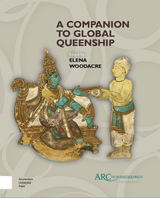 A Companion to Global Queenship
Elena Woodacre
Arc Humanities Press, 2018 This collection expands previous regional and individual studies of queenship and female political agency in order to engage in a comparative study of premodern female rule on a global scale. While the field of queenship studies and examinations of gender and power have been flourishing, the literature has tended to be dominated by studies of European royalty. This volume aims toembrace and develop the trend towards an increasingly global outlook for the field of queenship studies. Case studies of women from different periods, places, and religions are deliberately mixed to compare and contrast the realities of queenship in varied settings. Lesser studied examples of queens are provided alongside fresh perspectives on more familiar figures and regions. The authors increase our understanding of understudied individuals and groups of queens, and they encourage the comparison of the practice of queenship in the premodern era. This authoritative and comprehensive Companion will be required readingfor all scholars and students of premodern gender and political studies.
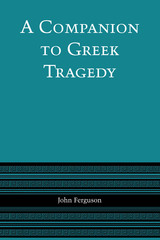 A Companion to Greek Tragedy
By John Ferguson
University of Texas Press, 1972 This handbook provides students and scholars with a highly readable yet detailed analysis of all surviving Greek tragedies and satyr plays. John Ferguson places each play in its historical, political, and social context—important for both Athenian and modern audiences—and he displays a keen, discriminating critical competence in dealing with the plays as literature. Ferguson is sensitive to the meter and sound of Greek tragedy, and, with remarkable success, he manages to involve even the Greekless reader in an actual encounter with the Greek as poetry. He examines language and metrics in relation to each tragedian's dramatic purpose, thus elucidating the crucial dimension of technique that other handbooks, mostly the work of philologists, renounce in order to concentrate on structure and plot. The result is perceptive criticism in which the quality of Ferguson's scholarship vouches for what he sees in the plays. The book is prefaced with a general introduction to ancient Greek theatrical production, and there is a brief biographical sketch of each tragedian. Footnotes are avoided: the object of this handbook is to introduce readers to the plays as dramatic poetry, not to detail who said what about them. There is an extensive bibliography for scholars and a glossary of Greek words to assist the student with the operative moral and stylistic terms of Greek tragedy.
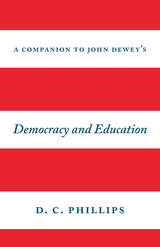 A Companion to John Dewey's "Democracy and Education"
D. C. Phillips
University of Chicago Press, 2016 This year marks the centenary publication of John Dewey’s magnum opus, Democracy and Education. Despite its profound importance as a foundational text in education, it is notoriously difficult and—dare we say it—a little dry. In this charming and often funny companion, noted philosopher of education D. C. Phillips goes chapter by chapter to bring Dewey to a twenty-first-century audience. Drawing on over fifty years of thinking about this book—and on his own experiences as an educator—he lends it renewed clarity and a personal touch that proves its lasting importance.
Phillips bridges several critical pitfalls of Democracy and Education that often prevent contemporary readers from fully understanding it. Where Dewey sorely needs a detailed example to illustrate a point—and the times are many—Phillips steps in, presenting cases from his own classroom experiences. Where Dewey casually refers to the works of people like Hegel, Herbart, and Locke—common knowledge, apparently, in 1916—Phillips fills in the necessary background. And where Dewey gets convoluted or is even flat-out wrong, Phillips does what few other scholars would do: he takes Dewey to task. The result is a lively accompaniment that helps us celebrate and be enriched by some of the most important ideas ever offered in education.
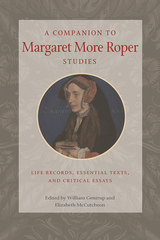 A Companion to Margaret More Roper Studies: Life Records, Essential Texts, and Critical Essays
Elizabeth McCutcheon
Catholic University of America Press, 2022 This volume is an important contribution to the field of Margaret More Roper studies, early modern women's writing, as well as Erasmian piety, Renaissance humanism, and historical and cultural studies more generally.
Margaret More Roper is the learned daughter of St. Thomas More, the Catholic martyr; their lives are closely linked to each other and to early sixteenth-century changes in politics and religion and the social upheaval and crises of conscience that they brought. Specifically, Roper's major works - her translation of Erasmus's commentary on the Lord's Prayer and the long dialogue letter between More and Roper on conscience - highlight two major preoccupations of the period: Erasmian humanism and More's last years, which led to his death and martyrdom.
Roper was one of the most learned women of her time and a prototype of the woman writer in England, and this edited volume is a tribute to her life, writings, and place among early women authors. It combines comprehensive and convenient joining of biographical, textual, historical, and critical components within a single volume for the modern reader. There is no comparable study in print, and it fills a significant gap in studies of early modern women writers.
A Companion to Martin Buber
Edited by Paul Mendes-Flohr
University of Chicago Press, 2025 A definitive, international guide to the thought of the most important twentieth-century Jewish philosopher.
In his 1923 essay, I and Thou, the philosopher, theologian, and activist Martin Buber introduced a philosophy of dialogue that achieved a global, interdisciplinary resonance. For Buber, dialogue was more than a conversation; dialogue discloses something essential about our orientation and our lives with one another. This companion assembles twenty-six scholars from a dozen countries to explore Buber’s international reputation and legacy in education, interfaith relations, Judaism, philosophy, politics, and psychology. The result is an essential guide to one of the most influential Jewish thinkers of the twentieth century.
A Companion to Medieval Pilgrimage
Andrew Jotischky
Arc Humanities Press, 2024 Pilgrimage to shrines and places of particular holiness was a feature of all three major religious traditions in medieval Europe and the eastern Mediterranean. Pilgrims exposed themselves to risk and loss in order to experience the spiritual benefits of devotion to the shrine of a saint or a holy place. This authoritative and comprehensive Companion offers a thematic approach to the experience of the medieval pilgrim, from departure to return. The central focus is on how pilgrims prepared for and negotiated their journeys; what they saw and did at shrines; and how they understood their journeys. The Holy Land stands at the centre of the book, because it was the main site of pilgrimage for Jewish, Christian, and Muslim pilgrims, but pilgrimages to other sites across Europe and the Near East, and to the shrines of local saints, are also explored.
A Companion to Medieval Translation
Jeanette Beer
Arc Humanities Press, 2019 <div>Translation played an essential role throughout the Middle Ages, bridging the gap between literate and lay, and enabling intercourse between languages in multi-lingual Europe. Medieval translation was extremely diverse, ranging from the literality and Latinity of legal documents to the free adaptation of courtly romance. </div><div>This guide to medieval translation covers a broad range of religious and vernacular texts and addresses the theoretical and pragmatic problems faced by modern translators of medieval works as they attempt to mediate between past and present.</div>
 Companion to Qualitative Analysis: Theory and Practice of Thick Analysis
Jeanine Evers
Amsterdam University Press, 2025 Qualitative analysis resembles a puzzle; you are confronted with a heap of data and you find yourself wondering: what should I do next? Ideally, you have already started the analysis before the amount of data becomes overwhelming. However, realistically, qualitative research inevitably generates a large amount of data that requires thorough organization, interpretation, combination and manipulation.
A Companion to Qualitative Analysis introduces the concept of Thick analysis, a triangulation strategy that enables you to systematically examine your data from a broad perspective to get the most out of your research. Part I of the book provides a theoretical overview of different analysis methods, the use of QDAS (qualitative data analysis software), ethical considerations and quality demands. Part II illustrates what the combination of different analyses of the same dataset by several researchers yields. And this is what Thick analysis is about!
Jeanine Evers wants to challenge you to think and grow, while reading and rereading, to understand what Thick analysis might mean for your own research. The book is appropriate for PhD, Master and Bachelor students and researchers in different phases of their career.
A Companion to State Power, Liberties and Rights
Edited by Sharon Morley, Jo Turner, Karen Corteen, and Paul Taylor
Bristol University Press, 2017 This handbook sets out, defines, and analyzes the essential vocabulary and terminology involved in the study of state power, individual liberties, and rights. As part of the Companions series, it is organized alphabetically, taking up and defining key topics in these areas, particularly as they relate to the study of crime and harm. Topics addressed include state and corporate crime, terrorism, security, risk, legislation and policy, human rights and civil liberties, policing, punishments and detention, surveillance and regulation, and many others. Accessible yet challenging, the book will be useful for both undergraduates and graduate students working in criminology, criminal justice, international relations, political science, and other fields.
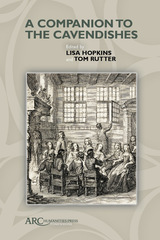 A Companion to the Cavendishes
Lisa Hopkins
Arc Humanities Press, 2021 The noble Cavendishes were one of the most influential families in the politics and culture of early modern England and beyond. A Companion to the Cavendishes offers a comprehensive account of the Cavendish family's creative output and cultural significance in the seventeenth century. It discusses the writings of individuals including William and Margaret Cavendish, and William's daughters Jane and Elizabeth; family members' work and patronage in other media such as music, architecture, and the visual arts; their participation in contemporary developments in politics, philosophy, and horsemanship; and the networks in which they moved both in England and in continental Europe. It also covers the work of less well-known family members such as the poet and biographer George Cavendish and the composer Michael Cavendish. This volume combines path-breaking scholarship with discussion of existing research, making it an invaluable resource for all those interested in this fascinating and diverse group of men and women.
A Companion to the Global Early Middle Ages
Erik Hermans
Arc Humanities Press, 2020 This companion introduces the connections between early medieval societies that have previously been studied in isolation. By bringing together nineteen experts on different regions across the globe, from Oceania to Europe and beyond, it transcends conventional disciplinary boundaries and synthesizes parallel historiographical narratives. The period 600-900 CE witnessed important historical developments, such as the establishment of a Southeast Asian thalassocracy by the Shailendra dynasty and the expansion of the Frankish polity under Charlemagne on the far ends of Eurasia and the consolidation of the Abbasid and Tang empires in between. A Companion to the Global Early Middle Ages integrates these contemporaneous processes and presents new insights into a neglected phase of world history.
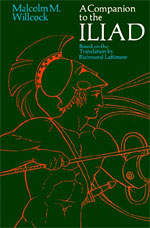 A Companion to The Iliad of Homer
Malcolm M. Willcock
University of Chicago Press, 1976 An essential handbook for any reader of the Iliad.
Those who are able to read Homer in Greek have ample recourse to commentaries, but the vast majority who read the Iliad in translation have not been so well served—the many available translations contain few, if any, notes. For these readers, Malcolm M. Willcock provides a line-by-line commentary that explains the many factual details, mythological allusions, and Homeric conventions that a student or general reader could not be expected to bring to an initial encounter with the Iliad.
The notes, which always relate to particular lines in the text, have as their prime aim the simple, factual explanation of things the inexperienced reader would be unlikely to have at his or her command (What is a hecatomb? Who is Atreus' son?). Second, they enhance an appreciation of the Iliad by illuminating epic style, Homer's methods of composition, the structure of the work, and the characterization of the major heroes. The "Homeric Question," concerning the origin and authorship of the Iliad, is also discussed.
The book's accessible commentary can be used with any translation of the poem, though it is based on Richmond Lattimore's landmark translation, which is regarded as the outstanding English-language version. This clearly written commentary, which includes an excellent select bibliography, makes of the touchstones of Western culture accessible to a wider audience.
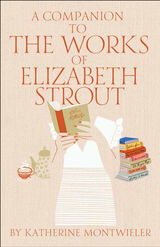 A Companion to the Works of Elizabeth Strout
Katherine Montwieler
Ohio University Press, 2022 Including an exclusive interview with bestselling American novelist Elizabeth Strout, this groundbreaking study will engage literature scholars and general readers alike. Written in accessible language, this book is the first to offer a sustained analysis of Elizabeth Strout’s work. A recipient of the Pulitzer Prize and the O. Henry Award, among other accolades, Strout has achieved a vast popular following as well. Amy and Isabelle was made into a television movie; Olive Kitteridge, which sold more than one million copies, was adapted as a miniseries; The Burgess Boys has been optioned for HBO; and My Name Is Lucy Barton was reimagined for the stage in London and on Broadway. Oh William!, the sequel to My Name Is Lucy Barton, appeared in 2021, and Strout’s latest book, Lucy by the Sea, is slated for release in fall 2022. At the height of her literary powers as a chronicler of American life and particularly the lives of American women, Strout is currently enjoying both commercial and critical success. Her sales and perennial presence on book club lists indicate a tremendous impact on the popular realm and the growing attention to her in academia charts her importance in American letters. This book will satisfy readers looking for a serious, in-depth introduction to Strout’s work, as well as those interested in women’s writing, contemporary fiction, ethics, and literature. It includes a new interview with Strout in which she discusses these issues. Montwieler traces the evolution of Strout’s voice, themes, and characters, which uniquely address American twenty-first-century feminine perspectives and sensibilities. From classic domestic spats between a mother and daughter to hate crimes aimed at mosques, from sweeping forays into decades past to snapshots of contemporary life, Strout compassionately portrays humanity at its most brutal and its most intimate. Though her canvas is vast, her eye for detail is astute and her ear for nuance is keen. Looking across Strout’s work, Montwieler explores how she portrays the endurance of hope, the complexities of family, the effects of trauma on individuals and communities, the sustaining power of the natural world, and the effects of place on personal and collective character. Strout’s creations cultivate empathy in her readers, teaching them to be attuned to the suffering of others and to the human need for connection. Across her work and in the new interview included within this book, Strout shows her readers that they are not alone in this impersonal, often violent world. The connection that acknowledges our limitations, our woundedness, our capability to do harm, our remorse, and our recognition of beauty and humor distinguishes Strout’s unique contribution to contemporary American letters.
Companions for the Passage: Stories of the Intimate Privilege of Accompanying the Dying
Marjorie Ryerson
University of Michigan Press, 2005 Companions for the Passage, from the author of the acclaimed Water Music, is an unforgettable book on a rarely visited subject: the personal stories of those who have witnessed the death of a loved one. Similar to works of Studs Terkel, author Marjorie Ryerson's interviews capture the human condition through their wide variety of experiences and voices.
Some of the interviewees are religious, some not; some encouraged their loved ones to accept death, others to fight it to the end. There are stories of heroic nurses and of indifferent hospital bureaucracies, of deaths that came too soon, and those that came at the end of a long, rich life. Possessing an affirmative quality that is anything but sentimental, ultimately these stories celebrate the experience of being present at the death of a loved one.
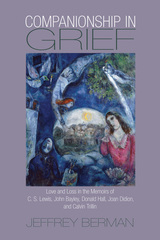 Companionship in Grief: Love and Loss in the Memoirs of C. S. Lewis, John Bayley, Donald Hall, Joan Didion, and Calvin Trillin
Jeffrey Berman
University of Massachusetts Press, 2010 In Companionship in Grief, Jeffrey Berman focuses on the most life-changing event for many people—the death of a spouse. Some of the most acclaimed memoirs of the past fifty years offer insights into this profound loss: C. S. Lewis's A Grief Observed; John Bayley's three memoirs about Iris Murdoch, including Elegy for Iris; Donald Hall's The Best Day the Worst Day; Joan Didion's best-selling The Year of Magical Thinking; and Calvin Trillin's About Alice. These books explore the nature of spousal bereavement, the importance of caregiving, the role of writing in recovery, and the possibility of falling in love again after a devastating loss. Throughout his study, Berman traces the theme of love and loss in all five memoirists' fictional and nonfictional writings as well as in those of their spouses, who were also accomplished writers. Combining literary studies, grief and bereavement theory, attachment theory, composition studies, and trauma theory, Companionship in Grief will appeal to anyone who has experienced love and loss. Berman's research casts light on five remarkable marriages, showing how autobiographical stories of love and loss can memorialize deceased spouses and offer wisdom and comfort to readers.
Company
Sam Ross
Four Way Books, 2019 Ross’s poems are at once earthy and delicate and view their subjects through a perceptive, picaresque lens.
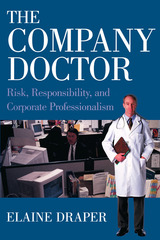 The Company Doctor: Risk, Responsibility, and Corporate Professionalism
Elaine Draper
Russell Sage Foundation, 2003 To limit the skyrocketing costs of their employees' health insurance, companies such as Dow, Chevron, and IBM, as well as many large HMOs, have increasingly hired physicians to supervise the medical care they provide. As Elaine Draper argues in The Company Doctor, company doctors are bound by two conflicting ideals: serving the medical needs of their patients while protecting the company's bottom line. Draper analyzes the advent of the corporate physician both as an independent phenomenon, and as an index of contemporary culture, reaching startling conclusions about the intersection of corporate culture with professional autonomy. Drawing on over 100 interviews with company physicians, scientists, and government and labor officials, as well as historical, legal, and statistical sources and medical trade association data, Draper presents an illuminating overview of the social context and meaning of professional work in corporations. Draper finds that while medical journals, speeches, and ethical codes proclaim the independent professional judgment of corporate physicians, the company doctors she interviewed often expressed anguish over the tightrope they must walk between their patients' health and the corporate oversight they face at every turn. Draper dissects the complex position occupied by company doctors to explore broad themes of doctor-patient trust, employee loyalty, privacy issues, and the future direction of medicine. She addresses such controversial topics as drug screening and the difficult position of company doctors when employees sue companies for health hazards in the workplace. Company doctors are but one example of professionals who have at times ceded their autonomy to corporate management. Physicians provide the prototypical professional case for exploring this phenomenon, due to their traditional independence, extensive training, and high levels of prestige. But Draper expands the scope of the book—tracing parallel developments in the law, science, and technology—to draw insightful conclusions about changing conditions in the professional workplace, as corporate cultures everywhere adapt to the new realities of the global economy. The Company Doctor provides a compelling examination of the corporatization of American medicine with far-reaching implications for professionals in many other fields.
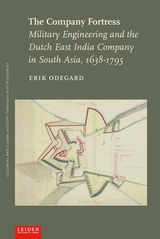 The Company Fortress: Military Engineering and the Dutch East India Company in South Asia, 1638-1795
Erik Odegard
Leiden University Press, 2020 The remains of Dutch East India Company forts are scattered throughout littoral Asia and Africa. But how important were the specific characteristics of European bastion-trace fortifications to Early Modern European expansion? The Company Fortress takes on this question by studying the system of fortifications built and maintained by the Dutch East India Company (VOC) in present-day India and Sri Lanka. It uncovers the stories of the forts and their designers, arguing that many of these engineers were in fact amateurs and their creations contained serious flaws. Subsequent engineers were hampered by their disagreement over fortification design: there proved not to be a single ‘European school’ of fortification design. The study questions the importance of fortification design for European expansion, shows the relationship between siege and naval warfare, and highlights changing perceptions by the VOC of the capabilities of new polities in India in the late eighteenth century.
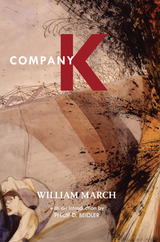 Company K
William March
University of Alabama Press, 1989 With an Introduction by Philip D. Beidler
This book was originally published in 1933. It is the first novel by William March, pen name for William Edward Campbell. Stemming directly from the author's experiences with the US Marines in France during World War I, the book consists of 113 sketches, or chapters, tracing the fictional Company K's war exploits and providing an emotional history of the men of the company that extends beyond the boundaries of the war itself.
William Edward Campbell served courageously in France as evidenced by his chestful of medals and certificates, including the Croix de Guerre, the Distinguished Service Cross, and the Navy Cross. However, without the medals and citations we would know of his bravery. For it is clear in the pages of Company K that this book was written by a man who had been to war, who had clearly seen his share of the worst of it, who had somehow survived, and who had committed himself afterward to the new bravery of sense-making embodied in the creation of major literary art. It is of that bravery that we still have the record of magnificent achievement, the brave terrible gift of Company K.
 Company Men: The Invention of Shareholder Value and the Splintering of the American Economy
Sean Delehanty
University of Chicago Press, 2025 How an esoteric economic theory—and its most devout believers—changed the world forever. In the modern economy, stock price is king. The value of a corporation is measured in how it enriches its shareholders, even when doing so subtracts from long-term growth or social good. Greed, in the last half-century of corporate practice, has become very good. Company Men is a sweeping intellectual history of how shareholder value rose from the lesser-known edges of academic theory to the vanguard of corporate practice. Historian Sean Delehanty marshals archival resources to reveal how a group of motivated consultants, activist investors, and academic economists successfully branded shareholder value as the antidote to problems of management and economic stagnation in the 1970s. In their success, they created a class of well-heeled managers who executed shareholder-value theory as an everyday practice—and at the expense of most everything else. Delehanty’s history of the modern American corporation is a sobering account of the business regime that would rule the world and produce no shortage of regrets—even amongst those who championed it. Company Men is intellectual history at its most vital, offering a surprising origin story of our economy’s discontents.
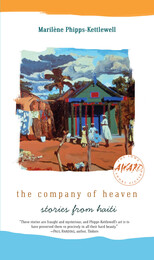 The Company of Heaven: Stories from Haiti
Marilène Phipps-Kettlewell
University of Iowa Press, 2010 Marilène Phipps-Kettlewell’s award-winning stories transport you to Haiti—to a lush, lyrical, flamboyant, and spirit-filled Haiti where palm trees shine wet with moonlight and the sky paints a yellow screen over your head and the ocean sparkles with thousands of golden eyes—and keep you there forever. Her singular characters mysteriously address the deeper meanings of human existence. They also dream of escape, whether from themselves, from family, from Vodou, from financial and cultural difficulties and the politicians that create them, or from the country itself, but Haiti will forever remain part of their souls and part of the thoughts of her readers. Some characters do achieve escape through the mind or through sea voyage—escape found by surrendering to spectacular fantasies and madness and love, bargaining with God, joining the boat people. Marie-Ange Saint-Jacques’s mother sacrifices everything to ensure her daughter’s survival on a perilous boat trip, Angelina waits to fly away to Nou Yòk, Vivi creates her own circus with dozens of rescued dogs, Gustave dies a martyr to his faith. Throughout, the “I” who moves in and out of these dream-filled stories embraces the heavenly mysteries found in “the room where all things lost are stored with grace.” We begin our journey to Haiti with images of a little girl in a pink bedroom reading by candlelight a book about the life of Saint Bernadette, surrounded by the bewitching scents, sounds, and textures of a Caribbean night. Each story stands by itself, but some characters can be followed from one story to another through the transformations they undergo as a result of their life experiences. In this way, the collection can be read as one story, the story of a family trapped in a personal and cultural drama and the story of the people with whom the family interacts, themselves burdened by the need to survive within Haiti’s rigorously class-determined society and blessed by their relationship to the company of heaven in which they live and for which they are destined.
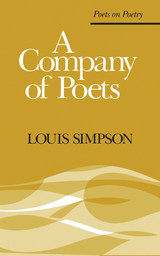 A Company of Poets
Louis Simpson
University of Michigan Press, 1981 This is a collection of essays, reviews, and interviews in which the author, himself a distinguished poet, expresses his ideas about the nature of poetry and criticizes his contemporaries. Simpson takes his stand with the “poetry of feeling” and agrees with Woodsworth that poetry should be written in a selection of the language “really spoken by men.” His reviews of American poets who have since become famous show Simpson to be an acute an innovative thinker. There are also essays on modern classics: Apollinaire, MacDiarmid, Lawrence, Crane, and Pound. The collection shows the full range of the critic of whom the Times Literary Supplement recently said: “Simpson’s critical and narrative voice is very distinctive – it is generous, sympathetic, spontaneously free and wittily fatalistic. Most originally, perhaps, this voice marries criticism, biography, literary and cultural history in an imaginative atmosphere of sheer wonder and discovery.”
The Company of Words: Hegel, Language, and Systematic Philosophy
John McCumber
Northwestern University Press, 1993 In this provocative work, John McCumber asks us to understand Hegel's system as a new approach to linguistic communication. Hegel, he argues, is concerned with building community and mutual comprehension rather than with completing metaphysics or developing historical critique. According to McCumber's radial interpretation, Hegel constructs a complex ideal of how we should use certain words. This ideal philosophical vocabulary is flexible and open to revision, and is constructed according to principles available at all time and all places; it is responsive to, but not dictated by, the shared language of cultured discourse whose concepts it attempts to refine and universalize.
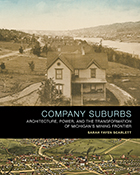 Company Suburbs: Architecture, Power, and the Transformation of Michigan's Mining Frontier
Sarah Fayen Scarlett
University of Tennessee Press, 2021 Winner of the 2022 Fred B. Kniffen Book Award from the International Society Landscape, Place, and Material Culture and the 2023 Abbott Lowell Cummings Award from the Vernacular Architecture Forum!
Michigan’s Keweenaw Peninsula juts into Lake Superior, pointing from the western Upper Peninsula toward Canada. Native peoples mined copper there for at least five thousand years, but the industrial heyday of the “Copper Country” began in the late nineteenth century, as immigrants from Cornwall, Italy, Finland, and elsewhere came to work in mines largely run from faraway cities such as New York and Boston. In those cities, suburbs had developed to allow wealthier classes to escape the dirt and grime of the industrial center. In the Copper Country, however, the suburbs sprang up nearly adjacent to mines, mills, and coal docks.
Sarah Fayen Scarlett contrasts two types of neighborhoods that transformed Michigan’s mining frontier between 1875 and 1920: paternalistic company towns built for the workers and elite suburbs created by the region’s network of business leaders. Richly illustrated with drawings, maps, and photographs, Company Suburbs details the development of these understudied cultural landscapes that arose when elites began to build housing that was architecturally distinct from that of the multiethnic workers within the old company towns. They followed national trends and created social hierarchies in the process, but also, uniquely, incorporated pre-existing mining features and adapted company housing practices. This idiosyncratic form of suburbanization belies the assumption that suburbs and industry were independent developments.
Built environments evince interrelationships among landscapes, people, and power. Scarlett’s work offers new perspectives on emerging national attitudes linking domestic architecture with class and gender identity. Company Suburbs complements scholarship on both industrial communities and early suburban growth, increasing our understanding of the ways hierarchies associated with industrial capitalism have been built into the shared environments of urban areas as well as seemingly peripheral American towns.
 Company Towns: Industry Power and the Historical Foundations of Public Mistrust
Elizabeth Mitchell Elder
University of Chicago Press Reveals the deep, historical roots of public distrust in former mining areas in the US, shedding new light on the corrosive feedback loops that persist today. In Company Towns, Elizabeth Mitchell Elder examines the long-lasting political legacies of mining-company dominance in the Midwest and Appalachia. While the economic consequences of deindustrialization are well-known, Elder shifts the focus to a more insidious problem: the political dysfunction that took root long before the mines shut down. Drawing on historical and administrative data, Elder shows that the coal industry hindered the growth of local government capacity in the places where it was dominant. Mining companies also engaged in outright corruption to shape local governments, practices which local elites then carried forward. When mining companies withdrew, they left behind not just economic decline, but local governments ill-equipped to govern. These patterns have had enduring consequences for public life. Elder shows how these historical experiences have fueled a broader cynicism toward government, in which citizens expect little from public institutions and doubt the usefulness of elections. Company Towns underscores the consequences of corporate dominance for state capacity, public opinion, and democratic accountability today.
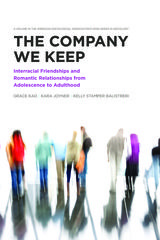 The Company We Keep: Interracial Friendships and Romantic Relationships from Adolescence to Adulthood
Grace Kao
Russell Sage Foundation, 2019 With hate crimes on the rise and social movements like Black Lives Matter bringing increased attention to the issue of police brutality, the American public continues to be divided by issues of race. How do adolescents and young adults form friendships and romantic relationships that bridge the racial divide? In The Company We Keep, sociologists Grace Kao, Kara Joyner, and Kelly Stamper Balistreri examine how race, gender, socioeconomic status, and other factors affect the formation of interracial friendships and romantic relationships among youth. They highlight two factors that increase the likelihood of interracial romantic relationships in young adulthood: attending a diverse school and having an interracial friendship or romance in adolescence.
While research on interracial social ties has often focused on whites and blacks, Hispanics are the largest minority group and Asian Americans are the fastest growing racial group in the United States. The Company We Keep examines friendships and romantic relationships among blacks, whites, Hispanics, and Asian Americans to better understand the full spectrum of contemporary race relations. Using data from the National Longitudinal Study of Adolescent to Adult Health, the authors explore the social ties of more than 15,000 individuals from their first survey responses as middle and high school students in the mid-1990s through young adulthood nearly fifteen years later. They find that while approval for interracial marriages has increased and is nearly universal among young people, interracial friendships and romantic relationships remain relatively rare, especially for whites and blacks. Black women are particularly disadvantaged in forming interracial romantic relationships, while Asian men are disadvantaged in the formation of any romantic relationships, both as adolescents and as young adults. They also find that people in same-sex romantic relationships are more likely to have partners from a different racial group than are people in different-sex relationships. The authors pay close attention to how the formation of interracial friendships and romantic relationships depends on opportunities for interracial contact. They find that the number of students choosing different-race friends and romantic partners is greater in schools that are more racially diverse, indicating that school segregation has a profound impact on young people’s social ties.
Kao, Joyner, and Balistreri analyze the ways school diversity and adolescent interracial contact intersect to lay the groundwork for interracial relationships in young adulthood. The Company We Keep provides compelling insights and hope for the future of living and loving across racial divides.
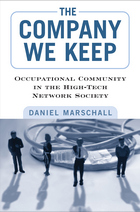 The Company We Keep: Occupational Community in the High-Tech Network Society
Daniel Marschall
Temple University Press, 2014 At the birth of the Internet Age, computer technologists in small, aggressive software development companies became part of a unique networked occupational community. They were creative, team-oriented, and enthusiastic workers who built "boundaryless careers," hopping from one employer to another.
In his absorbing ethnography The Company We Keep, sociologist Daniel Marschall immerses himself in IntenSivity, one such technological workplace. Chronicling the employees' experiences, Marschall examines how these workers characterize their occupational culture, share values and work practices, and help one another within their community. He sheds light on the nature of this industry marked by highly skilled jobs and rapid technological change.
The experiences at IntenSivity are now mirrored by employees at Facebook and thousands of other cutting-edge, high-tech start-up firms. The Company We Keep helps us understand the emergence of virtual work communities and the character of the contemporary labor market at the level of a small enterprise.
 The Comparative Anatomy and Histology of the Cerebellum: From Monotremes through Apes
Olof LarsellJan Jansen, Editor
University of Minnesota Press, 1970 The Comparative Anatomy and Histology of the Cerebellum was first published in 1970. Minnesota Archive Editions uses digital technology to make long-unavailable books once again accessible, and are published unaltered from the original University of Minnesota Press editions. This is the second volume of the late Dr. Larsell's comprehensive monograph on the cerebellum, the first volume of which is described below. A third volume, on the human cerebellum, will be published by the University of Minnesota Press next spring to complete the work. This second volume deals with the morphogenetic development and morphology of the cerebellum of all orders of mammals from monotremes through apes. The descriptions cover the cerebellum in about forty species with special emphasis on the cerebellum of the albino rate, rabbit, cat, and rhesus monkey. Dr. Larsell's comparative anatomical studies over a period of many years led to the conclusion that fundamentally the mammalian cerebellum is composed of ten subdivisions. With few exceptions (the smallest and most primitive cerebella) the subdivisions are identified in all mammals. The descriptions of the cerebella are based on the author's personal investigations but the relevant literature is thoroughly reviewed also.
 The Comparative Anatomy and Histology of the Cerebellum: The Human Cerebellum, Cerebellar Connections, and Cerebellar Cortex
Olof Larsell and Jan JansenForeword by Robert S. Dow
University of Minnesota Press, 1972 The Comparative Anatomy and Histology of the Cerebellum was first published in 1972. Minnesota Archive Editions uses digital technology to make long-unavailable books once again accessible, and are published unaltered from the original University of Minnesota Press editions. This is the third and final volume of the late Dr. Larsell's definitive work on the cerebellum, brought to completion for publication by Dr. Jansen. Two additional contributing authors for this volume are Enrico Mugnaini, M.D., and Helge K. Korneliussen, M.D. The first section of this volume deals with the morphology of the human cerebellum. The morphogenetic development, the fissure formation, and the differentiation of the cerebellar lobules are described in detail, and followed by a comprehensive account of the adult cerebellum, its lobes and lobules. It is shown that the ten major lobules which Dr. Larsell distinguished in other mammals are recognizable also in man. Chapters on the cerebellum connections include detailed accounts of all afferent and efferent cerebellar tracts. A subsequent chapter, by Drs. Jansen and Korneliussen, is devoted to the fundamental plan of cerebellar organization. The final chapters, by Dr. Mugnaini, deal with the histology and cytology of the cerebellar cortex. A comprehensive account is given of electron micrographs, a virtual atlas of the ultrastructure of the cerebellar cortex, illustrate the description.
Comparative Anthropology of Ancient Greece
Marcel Detienne
Harvard University Press, 2009 Comparative Anthropology of Ancient Greece looks at the anthropology of the Greeks and other cultures across space and time, and in the process discovers aspects of the art of comparability. Historians and ethnologists can pool a wealth of knowledge about different cultures across space and time. Their joint task is to analyze human societies and to understand cultural products. Comparative analysis involves working together in an experimental and constructive enterprise. Marcel Detienne, alerted by dissonances, tries to see how cultural systems react not just to a touchstone category, but also to the questions and concepts that arise from the reaction. What does it mean to found something, or rather to establish a territory, or to have or not have roots? What is a site or a place?
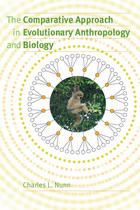 The Comparative Approach in Evolutionary Anthropology and Biology
Charles L. Nunn
University of Chicago Press, 2011 Comparison is fundamental to evolutionary anthropology. When scientists study chimpanzee cognition, for example, they compare chimp performance on cognitive tasks to the performance of human children on the same tasks. And when new fossils are found, such as those of the tiny humans of Flores, scientists compare these remains to other fossils and contemporary humans. Comparison provides a way to draw general inferences about the evolution of traits and therefore has long been the cornerstone of efforts to understand biological and cultural diversity. Individual studies of fossilized remains, living species, or human populations are the essential units of analysis in a comparative study; bringing these elements into a broader comparative framework allows the puzzle pieces to fall into place, creating a means of testing adaptive hypotheses and generating new ones. With this book, Charles L. Nunn intends to ensure that evolutionary anthropologists and organismal biologists have the tools to realize the potential of comparative research. Nunn provides a wide-ranging investigation of the comparative foundations of evolutionary anthropology in past and present research, including studies of animal behavior, biodiversity, linguistic evolution, allometry, and cross-cultural variation. He also points the way to the future, exploring the new phylogeny-based comparative approaches and offering a how-to manual for scientists who wish to incorporate these new methods into their research.
 The Comparative Approach in Evolutionary Anthropology and Biology
Charles L. Nunn
University of Chicago Press, 2011 Comparison is fundamental to evolutionary anthropology. When scientists study chimpanzee cognition, for example, they compare chimp performance on cognitive tasks to the performance of human children on the same tasks. And when new fossils are found, such as those of the tiny humans of Flores, scientists compare these remains to other fossils and contemporary humans. Comparison provides a way to draw general inferences about the evolution of traits and therefore has long been the cornerstone of efforts to understand biological and cultural diversity. Individual studies of fossilized remains, living species, or human populations are the essential units of analysis in a comparative study; bringing these elements into a broader comparative framework allows the puzzle pieces to fall into place, creating a means of testing adaptive hypotheses and generating new ones.
With this book, Charles L. Nunn intends to ensure that evolutionary anthropologists and organismal biologists have the tools to realize the potential of comparative research. Nunn provides a wide-ranging investigation of the comparative foundations of evolutionary anthropology in past and present research, including studies of animal behavior, biodiversity, linguistic evolution, allometry, and cross-cultural variation. He also points the way to the future, exploring the new phylogeny-based comparative approaches and offering a how-to manual for scientists who wish to incorporate these new methods into their research.
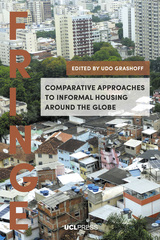 Comparative Approaches to Informal Housing Around the Globe
Edited by Udo Grashoff
University College London, 2020 How do squatting settlements in Kyrgyzstan and Kazakhstan differ from right-wing squatting in Germany? What commonalities does squatting activism in Brazil and Spain share with squatting in post-World War II UK and Australia? In Comparative Approaches to Informal Housing Around the Globe historians, anthropologists, political scientists, sociologists, urban planners, and political activists come together to break new ground in exploring the globalization of knowledge about informal housing. Coming from a diverse collection of perspectives and places, they compare informal settlements, unauthorized occupation of flats, illegal housing construction, and political squatting all around the world.
The contributors to Comparative Approaches to Informal Housing Around the Globe engage with a sweeping variety of topics and contribute specialist knowledge from Africa, Asia, Australia, the Middle East, North and South America, and Eastern and Western Europe. Bringing together such a wide range of authors and subjects demonstrates the power of comparative research to open new perspectives.
Comparative Arawakan Histories: Rethinking Language Family and Culture Area in Amazonia
Edited by Jonathan D. Hill and Fernando Santos-Granero
University of Illinois Press, 2002 Before they were largely decimated and dispersed by the effects of European colonization, Arawak-speaking peoples were the most widespread language family in Latin America and the Caribbean, and they were the first people Columbus encountered in the Americas. Comparative Arawakan Histories, in paperback for the first time, examines social structures, political hierarchies, rituals, religious movements, gender relations, and linguistic variations through historical perspectives to document sociocultural diversity across the diffused Arawakan diaspora.
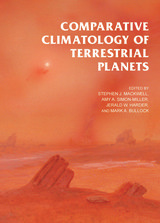 Comparative Climatology of Terrestrial Planets
Edited by Stephen J. Mackwell, Amy A. Simon-Miller, Jerald W. Harder, and Mark A. Bullock
University of Arizona Press, 2014 The early development of life, a fundamental question for humankind, requires the presence of a suitable planetary climate. Our understanding of how habitable planets come to be begins with the worlds closest to home. Venus, Earth, and Mars differ only modestly in their mass and distance from the Sun, yet their current climates could scarcely be more divergent. Only Earth has abundant liquid water, Venus has a runaway greenhouse, and evidence for life-supporting conditions on Mars points to a bygone era. In addition, an Earth-like hydrologic cycle has been revealed in a surprising place: Saturn’s cloud-covered satellite Titan has liquid hydrocarbon rain, lakes, and river networks. Deducing the initial conditions for these diverse worlds and unraveling how and why they diverged to their current climates is a challenge at the forefront of planetary science. Through the contributions of more than sixty leading experts in the field, Comparative Climatology of Terrestrial Planets sets forth the foundations for this emerging new science and brings the reader to the forefront of our current understanding of atmospheric formation and climate evolution. Particular emphasis is given to surface-atmosphere interactions, evolving stellar flux, mantle processes, photochemistry, and interactions with the interplanetary environment, all of which influence the climatology of terrestrial planets. From this cornerstone, both current professionals and most especially new students are brought to the threshold, enabling the next generation of new advances in our own solar system and beyond. Contents Part I: Foundations
Jim Hansen
Mark Bullock
Scot Rafkin
Caitlin Griffith
Shawn Domagal-Goldman and Antigona Segura
Kevin Zahnle
Part II: The Greenhouse Effect and Atmospheric Dynamics
Curt Covey
G. Schubert and J. Mitchell
Tim Dowling
Francois Forget and Sebastien Lebonnois
Vladimir Krasnopolsky
Adam Showman
Part III: Clouds, Hazes, and Precipitation
Larry Esposito
A. Määttänen, K. Pérot, F. Montmessin, and A. Hauchecorne
Nilton Renno
Zibi Turtle
Mark Marley
Part IV: Surface-Atmosphere Interactions
Colin Goldblatt
Teresa Segura et al.
John Grotzinger
Adrian Lenardic
D. A. Brain, F. Leblanc, J. G. Luhmann, T. E. Moore, and F. Tian
Part V: Solar Influences on Planetary Climate
Aaron Zent
Jerry Harder
F. Tian, E. Chassefiere, F. Leblanc, and D. Brain
David Des Marais
 A Comparative Dictionary of Raute and Rawat: Tibeto-Burman Languages of the Central Himalayas
Jana Fortier
Harvard University Press Raute and Rawat are endangered languages belonging to the Raji-Raute language cluster within the large Sino-Tibetan family of languages spoken across Asia. The Raute and Rawat people are forest foragers in the central Himalayan region, living by hunting, gathering, and trade of wooden carvings to outsiders. Their remarkably conservative mother tongues contain a wealth of concepts about egalitarianism, religious animism, and aspects of forest life. Understanding these language concepts may provide a better appreciation of the cultural history of forest-dwelling peoples in Asia and a way of living that is in danger of becoming obsolete—as farming communities convert the forests to fields and people face pressure to assimilate.
The dictionary provides a full description of each entry, including a provenance of its speech community, the part of speech, and a gloss in English, Nepali, and Kumauni. In addition, most entries contain an example of usage in a sample sentence, notes on cultural significance, and a meticulously studied etymology. The book provides a useful reference work with previously unpublished information about the speakers’ ethnic identities and their culturally significant plants, animals, deities, and material culture.
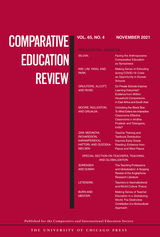 Comparative Education Review, volume 65 number 4 (November 2021)
The University of Chicago Press
University of Chicago Press Journals, 2021 This is volume 65 issue 4 of Comparative Education Review. The Comparative Education Review (CER) is the flagship journal of the Comparative and International Education Society. Its editorial team pursues greater critical engagement, interrogation and innovation in the field of comparative and international education. The journal publishes intellectually rigorous original research in both theoretical and practical applications, seeking representation across sexual, ethnic, cultural and religious diversity. Further, the editors seek to advance the field by bringing greater awareness to discourses on education across the lifespan in historically underrepresented regions, contexts, and topics. CER promotes multidisciplinary research, valuing diverse perspectives and methodologies in order to expand and transgress current ways of knowing and understanding education throughout the world. Through publishing eclectic scholarship, the CER editorial team seeks to engage a wide-ranging community of scholars, practitioners, and policy-makers.
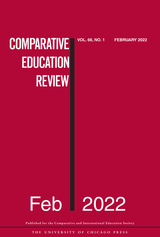 Comparative Education Review, volume 66 number 1 (February 2022)
The University of Chicago Press
University of Chicago Press Journals, 2022 This is volume 66 issue 1 of Comparative Education Review. The Comparative Education Review (CER) is the flagship journal of the Comparative and International Education Society. Its editorial team pursues greater critical engagement, interrogation and innovation in the field of comparative and international education. The journal publishes intellectually rigorous original research in both theoretical and practical applications, seeking representation across sexual, ethnic, cultural and religious diversity. Further, the editors seek to advance the field by bringing greater awareness to discourses on education across the lifespan in historically underrepresented regions, contexts, and topics. CER promotes multidisciplinary research, valuing diverse perspectives and methodologies in order to expand and transgress current ways of knowing and understanding education throughout the world. Through publishing eclectic scholarship, the CER editorial team seeks to engage a wide-ranging community of scholars, practitioners, and policy-makers.
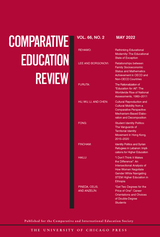 Comparative Education Review, volume 66 number 2 (May 2022)
The University of Chicago Press
University of Chicago Press Journals, 2022 This is volume 66 issue 2 of Comparative Education Review. The Comparative Education Review (CER) is the flagship journal of the Comparative and International Education Society. Its editorial team pursues greater critical engagement, interrogation and innovation in the field of comparative and international education. The journal publishes intellectually rigorous original research in both theoretical and practical applications, seeking representation across sexual, ethnic, cultural and religious diversity. Further, the editors seek to advance the field by bringing greater awareness to discourses on education across the lifespan in historically underrepresented regions, contexts, and topics. CER promotes multidisciplinary research, valuing diverse perspectives and methodologies in order to expand and transgress current ways of knowing and understanding education throughout the world. Through publishing eclectic scholarship, the CER editorial team seeks to engage a wide-ranging community of scholars, practitioners, and policy-makers.
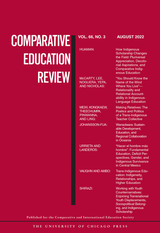 Comparative Education Review, volume 66 number 3 (August 2022)
The University of Chicago Press
University of Chicago Press Journals, 2022 This is volume 66 issue 3 of Comparative Education Review. The Comparative Education Review (CER) is the flagship journal of the Comparative and International Education Society. Its editorial team pursues greater critical engagement, interrogation and innovation in the field of comparative and international education. The journal publishes intellectually rigorous original research in both theoretical and practical applications, seeking representation across sexual, ethnic, cultural and religious diversity. Further, the editors seek to advance the field by bringing greater awareness to discourses on education across the lifespan in historically underrepresented regions, contexts, and topics. CER promotes multidisciplinary research, valuing diverse perspectives and methodologies in order to expand and transgress current ways of knowing and understanding education throughout the world. Through publishing eclectic scholarship, the CER editorial team seeks to engage a wide-ranging community of scholars, practitioners, and policy-makers.
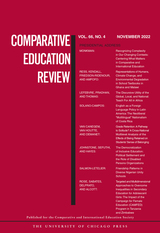 Comparative Education Review, volume 66 number 4 (November 2022)
The University of Chicago Press
University of Chicago Press Journals, 2022 This is volume 66 issue 4 of Comparative Education Review. The Comparative Education Review (CER) is the flagship journal of the Comparative and International Education Society. Its editorial team pursues greater critical engagement, interrogation and innovation in the field of comparative and international education. The journal publishes intellectually rigorous original research in both theoretical and practical applications, seeking representation across sexual, ethnic, cultural and religious diversity. Further, the editors seek to advance the field by bringing greater awareness to discourses on education across the lifespan in historically underrepresented regions, contexts, and topics. CER promotes multidisciplinary research, valuing diverse perspectives and methodologies in order to expand and transgress current ways of knowing and understanding education throughout the world. Through publishing eclectic scholarship, the CER editorial team seeks to engage a wide-ranging community of scholars, practitioners, and policy-makers.
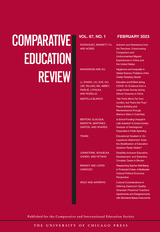 Comparative Education Review, volume 67 number 1 (February 2023)
The University of Chicago Press
University of Chicago Press Journals, 2023 This is volume 67 issue 1 of Comparative Education Review. The Comparative Education Review (CER) is the flagship journal of the Comparative and International Education Society. Its editorial team pursues greater critical engagement, interrogation and innovation in the field of comparative and international education. The journal publishes intellectually rigorous original research in both theoretical and practical applications, seeking representation across sexual, ethnic, cultural and religious diversity. Further, the editors seek to advance the field by bringing greater awareness to discourses on education across the lifespan in historically underrepresented regions, contexts, and topics. CER promotes multidisciplinary research, valuing diverse perspectives and methodologies in order to expand and transgress current ways of knowing and understanding education throughout the world. Through publishing eclectic scholarship, the CER editorial team seeks to engage a wide-ranging community of scholars, practitioners, and policy-makers.
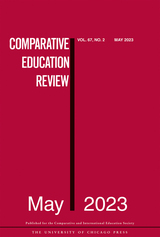 Comparative Education Review, volume 67 number 2 (May 2023)
The University of Chicago Press
University of Chicago Press Journals, 2023 This is volume 67 issue 2 of Comparative Education Review. The Comparative Education Review (CER) is the flagship journal of the Comparative and International Education Society. Its editorial team pursues greater critical engagement, interrogation and innovation in the field of comparative and international education. The journal publishes intellectually rigorous original research in both theoretical and practical applications, seeking representation across sexual, ethnic, cultural and religious diversity. Further, the editors seek to advance the field by bringing greater awareness to discourses on education across the lifespan in historically underrepresented regions, contexts, and topics. CER promotes multidisciplinary research, valuing diverse perspectives and methodologies in order to expand and transgress current ways of knowing and understanding education throughout the world. Through publishing eclectic scholarship, the CER editorial team seeks to engage a wide-ranging community of scholars, practitioners, and policy-makers.
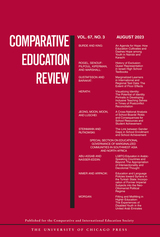 Comparative Education Review, volume 67 number 3 (August 2023)
The University of Chicago Press
University of Chicago Press Journals, 2023 This is volume 67 issue 3 of Comparative Education Review. The Comparative Education Review (CER) is the flagship journal of the Comparative and International Education Society. Its editorial team pursues greater critical engagement, interrogation and innovation in the field of comparative and international education. The journal publishes intellectually rigorous original research in both theoretical and practical applications, seeking representation across sexual, ethnic, cultural and religious diversity. Further, the editors seek to advance the field by bringing greater awareness to discourses on education across the lifespan in historically underrepresented regions, contexts, and topics. CER promotes multidisciplinary research, valuing diverse perspectives and methodologies in order to expand and transgress current ways of knowing and understanding education throughout the world. Through publishing eclectic scholarship, the CER editorial team seeks to engage a wide-ranging community of scholars, practitioners, and policy-makers.
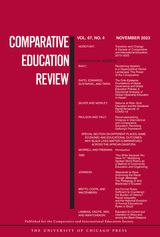 Comparative Education Review, volume 67 number 4 (November 2023)
The University of Chicago Press
University of Chicago Press Journals, 2023 This is volume 67 issue 4 of Comparative Education Review. The Comparative Education Review (CER) is the flagship journal of the Comparative and International Education Society. Its editorial team pursues greater critical engagement, interrogation and innovation in the field of comparative and international education. The journal publishes intellectually rigorous original research in both theoretical and practical applications, seeking representation across sexual, ethnic, cultural and religious diversity. Further, the editors seek to advance the field by bringing greater awareness to discourses on education across the lifespan in historically underrepresented regions, contexts, and topics. CER promotes multidisciplinary research, valuing diverse perspectives and methodologies in order to expand and transgress current ways of knowing and understanding education throughout the world. Through publishing eclectic scholarship, the CER editorial team seeks to engage a wide-ranging community of scholars, practitioners, and policy-makers.
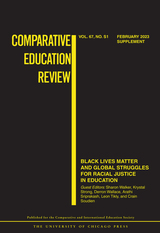 Comparative Education Review, volume 67 number S1 (February 2023)
The University of Chicago Press
University of Chicago Press Journals, 2023 This is volume 67 issue S1 of Comparative Education Review. The Comparative Education Review (CER) is the flagship journal of the Comparative and International Education Society. Its editorial team pursues greater critical engagement, interrogation and innovation in the field of comparative and international education. The journal publishes intellectually rigorous original research in both theoretical and practical applications, seeking representation across sexual, ethnic, cultural and religious diversity. Further, the editors seek to advance the field by bringing greater awareness to discourses on education across the lifespan in historically underrepresented regions, contexts, and topics. CER promotes multidisciplinary research, valuing diverse perspectives and methodologies in order to expand and transgress current ways of knowing and understanding education throughout the world. Through publishing eclectic scholarship, the CER editorial team seeks to engage a wide-ranging community of scholars, practitioners, and policy-makers.
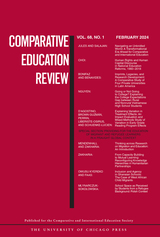 Comparative Education Review, volume 68 number 1 (February 2024)
The University of Chicago Press
University of Chicago Press Journals, 2024 This is volume 68 issue 1 of Comparative Education Review. The Comparative Education Review (CER) is the flagship journal of the Comparative and International Education Society. Its editorial team pursues greater critical engagement, interrogation and innovation in the field of comparative and international education. The journal publishes intellectually rigorous original research in both theoretical and practical applications, seeking representation across sexual, ethnic, cultural and religious diversity. Further, the editors seek to advance the field by bringing greater awareness to discourses on education across the lifespan in historically underrepresented regions, contexts, and topics. CER promotes multidisciplinary research, valuing diverse perspectives and methodologies in order to expand and transgress current ways of knowing and understanding education throughout the world. Through publishing eclectic scholarship, the CER editorial team seeks to engage a wide-ranging community of scholars, practitioners, and policy-makers.
 Comparative Education Review, volume 68 number 2 (May 2024)
The University of Chicago Press
University of Chicago Press Journals, 2024 This is volume 68 issue 2 of Comparative Education Review. The Comparative Education Review (CER) is the flagship journal of the Comparative and International Education Society. Its editorial team pursues greater critical engagement, interrogation and innovation in the field of comparative and international education. The journal publishes intellectually rigorous original research in both theoretical and practical applications, seeking representation across sexual, ethnic, cultural and religious diversity. Further, the editors seek to advance the field by bringing greater awareness to discourses on education across the lifespan in historically underrepresented regions, contexts, and topics. CER promotes multidisciplinary research, valuing diverse perspectives and methodologies in order to expand and transgress current ways of knowing and understanding education throughout the world. Through publishing eclectic scholarship, the CER editorial team seeks to engage a wide-ranging community of scholars, practitioners, and policy-makers.
 Comparative Education Review, volume 68 number 3 (August 2024)
The University of Chicago Press
University of Chicago Press Journals, 2024 This is volume 68 issue 3 of Comparative Education Review. The Comparative Education Review (CER) is the flagship journal of the Comparative and International Education Society. Its editorial team pursues greater critical engagement, interrogation and innovation in the field of comparative and international education. The journal publishes intellectually rigorous original research in both theoretical and practical applications, seeking representation across sexual, ethnic, cultural and religious diversity. Further, the editors seek to advance the field by bringing greater awareness to discourses on education across the lifespan in historically underrepresented regions, contexts, and topics. CER promotes multidisciplinary research, valuing diverse perspectives and methodologies in order to expand and transgress current ways of knowing and understanding education throughout the world. Through publishing eclectic scholarship, the CER editorial team seeks to engage a wide-ranging community of scholars, practitioners, and policy-makers.
 Comparative Education Review, volume 68 number 4 (November 2024)
The University of Chicago Press
University of Chicago Press Journals, 2024 This is volume 68 issue 4 of Comparative Education Review. The Comparative Education Review (CER) is the flagship journal of the Comparative and International Education Society. Its editorial team pursues greater critical engagement, interrogation and innovation in the field of comparative and international education. The journal publishes intellectually rigorous original research in both theoretical and practical applications, seeking representation across sexual, ethnic, cultural and religious diversity. Further, the editors seek to advance the field by bringing greater awareness to discourses on education across the lifespan in historically underrepresented regions, contexts, and topics. CER promotes multidisciplinary research, valuing diverse perspectives and methodologies in order to expand and transgress current ways of knowing and understanding education throughout the world. Through publishing eclectic scholarship, the CER editorial team seeks to engage a wide-ranging community of scholars, practitioners, and policy-makers.
 Comparative Education Review, volume 69 number 1 (February 2025)
The University of Chicago Press
University of Chicago Press Journals, 2025 This is volume 69 issue 1 of Comparative Education Review. The Comparative Education Review (CER) is the flagship journal of the Comparative and International Education Society. Its editorial team pursues greater critical engagement, interrogation and innovation in the field of comparative and international education. The journal publishes intellectually rigorous original research in both theoretical and practical applications, seeking representation across sexual, ethnic, cultural and religious diversity. Further, the editors seek to advance the field by bringing greater awareness to discourses on education across the lifespan in historically underrepresented regions, contexts, and topics. CER promotes multidisciplinary research, valuing diverse perspectives and methodologies in order to expand and transgress current ways of knowing and understanding education throughout the world. Through publishing eclectic scholarship, the CER editorial team seeks to engage a wide-ranging community of scholars, practitioners, and policy-makers.
 Comparative Education Review, volume 69 number 2 (May 2025)
The University of Chicago Press
University of Chicago Press Journals, 2025 This is volume 69 issue 2 of Comparative Education Review. The Comparative Education Review (CER) is the flagship journal of the Comparative and International Education Society. Its editorial team pursues greater critical engagement, interrogation and innovation in the field of comparative and international education. The journal publishes intellectually rigorous original research in both theoretical and practical applications, seeking representation across sexual, ethnic, cultural and religious diversity. Further, the editors seek to advance the field by bringing greater awareness to discourses on education across the lifespan in historically underrepresented regions, contexts, and topics. CER promotes multidisciplinary research, valuing diverse perspectives and methodologies in order to expand and transgress current ways of knowing and understanding education throughout the world. Through publishing eclectic scholarship, the CER editorial team seeks to engage a wide-ranging community of scholars, practitioners, and policy-makers.
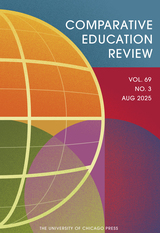 Comparative Education Review, volume 69 number 3 (August 2025)
The University of Chicago Press
University of Chicago Press Journals, 2025 This is volume 69 issue 3 of Comparative Education Review. The Comparative Education Review (CER) is the flagship journal of the Comparative and International Education Society. Its editorial team pursues greater critical engagement, interrogation and innovation in the field of comparative and international education. The journal publishes intellectually rigorous original research in both theoretical and practical applications, seeking representation across sexual, ethnic, cultural and religious diversity. Further, the editors seek to advance the field by bringing greater awareness to discourses on education across the lifespan in historically underrepresented regions, contexts, and topics. CER promotes multidisciplinary research, valuing diverse perspectives and methodologies in order to expand and transgress current ways of knowing and understanding education throughout the world. Through publishing eclectic scholarship, the CER editorial team seeks to engage a wide-ranging community of scholars, practitioners, and policy-makers.
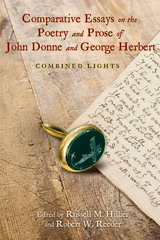 Comparative Essays on the Poetry and Prose of John Donne and George Herbert: Combined Lights
Russell M. Hillier
University of Delaware Press, 2022 This book brings together ten essays on John Donne and George Herbert composed by an international group of scholars. The volume represents the first collection of its kind to draw close connections between these two distinguished early modern thinkers and poets who are justly coupled because of their personal and artistic association. The contributors' distinctive new approaches and insights illuminate a variety of topics and fields while suggesting new directions that future study of Donne and Herbert might take. Some chapters explore concrete instances of collaboration or communication between Donne and Herbert, and others find fresh ways to contextualize the Donnean and Herbertian lyric, carefully setting the poetry alongside discourses of apophatic theology or early modern political theory, while still others link Herbert's verse to Donne's devotional prose. Several chapters establish specific theological and aesthetic grounds for comparison, considering Donne and Herbert's respective positions on religious assurance, comic sensibility, and virtuosity with poetic endings.
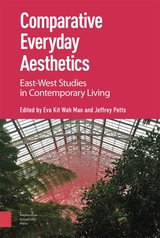 Comparative Everyday Aesthetics: East-West Studies in Contemporary Living
Eva Kit Wah Man
Amsterdam University Press, 2023 Leading international scholars present analysis and case studies from different cultural settings, East and West, exploring aesthetic interest and experience in our daily lives at home, in workplaces, using everyday things, in our built and natural environments, and in our relationships and communities. A wide range of views and examples of everyday aesthetics are presented from western philosophical paradigms, from Confucian and Daoist aesthetics, and from the Japanese tradition. All indicate universal features of human aesthetic lives together with their cultural variations. Comparative Everyday Aesthetics is a significant contribution to a key trend in international aesthetics for thinking beyond narrow art-centered conceptions of the aesthetic. It generates global discussions about good, aesthetic, everyday living in all its various aspects. It also promotes aesthetic education for personal, social, and environmental development and presents opportunities for global collaborative projects in philosophical aesthetics.
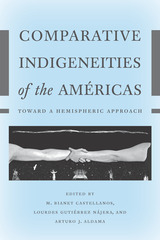 Comparative Indigeneities of the Américas: Toward a Hemispheric Approach
Edited by M. Bianet Castellanos, Lourdes Gutiérrez Nájera, and Arturo J. Aldama
University of Arizona Press, 2012 The effects of colonization on the Indigenous peoples of the Américas over the past 500 years have varied greatly. So too have the forms of resistance, resilience, and sovereignty. In the face of these differences, the contributors to this volume contend that understanding the commonalities in these Indigenous experiences will strengthen resistance to colonial forces still at play. This volume marks a critical moment in bringing together transnational and interdisciplinary scholarship to articulate new ways of pursuing critical Indigenous studies.
Comparative Indigeneities of the Américas highlights intersecting themes such as indigenísmo, mestizaje, migration, displacement, autonomy, sovereignty, borders, spirituality, and healing that have historically shaped the experiences of Native peoples across the Américas. In doing so, it promotes a broader understanding of the relationships between Native communities in the United States and Canada and those in Latin America and the Caribbean and invites a hemispheric understanding of the relationships between Native and mestiza/o peoples.
Through path-breaking approaches to transnational, multidisciplinary scholarship and theory, the chapters in this volume advance understandings of indigeneity in the Américas and lay a strong foundation for further research. This book will appeal to scholars and students in the fields of anthropology, literary and cultural studies, history, Native American and Indigenous studies, women and gender studies, Chicana/o studies, and critical ethnic studies.
Ultimately, this deeply informative and empowering book demonstrates the various ways that Indigenous and mestiza/o peoples resist state and imperial attempts to erase, repress, circumscribe, and assimilate them.
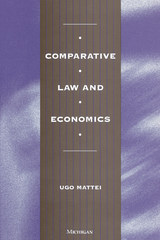 Comparative Law and Economics
Ugo Mattei
University of Michigan Press, 1998 The comparative study of law and the institutions of law have enriched our understanding of the role law plays in our society by comparing law and legal institutions in different countries, but we have lacked a strong theoretical structure. Scholars studying the role of law in society by applying economic theories have offered a parsimonious theoretical structure with which to understand the relationship between law and society but have tended to focus only on American legal issues. Ugo Mattei joins insights from both areas of scholarship in a productive relationship that furthers our understanding of why societies adopt different laws and why some societies share similar laws.
Mattei shows how concepts from economics can be applied to the study of comparative law. He then applies the concepts to several significant problems in comparative law, including the history and sources of law, differences between civil and common law systems, and the reasons for legal change and the movement of law from one country to another. He looks at specific problems in property, contracts, and trust law. Finally he uses the insights he has developed to understand the issues involved in changing law in developing countries and in formerly socialist countries.
This book will be of interest to scholars of law, economics, and development, as well as those interested in transformation in formerly communist states.
Ugo Mattei is Alfred and Hanna Fromm Professor of International and Comparative Law, Hastings College of Law, University of California; and Professor of Civil Law, University of Trento.
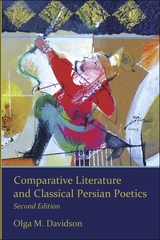 Comparative Literature and Classical Persian Poetics: Second Edition
Olga M. Davidson
Harvard University Press Comparative Literature and Classical Persian Poetics applies comparative literary approaches to classical Persian traditions of composing and performing poetry and song. Olga M. Davidson focuses on epic, especially the classical epic Shāhnāma, composed in the early eleventh century CE by the poet Ferdowsi, and on the relationship of this epic to other genres that are found embedded in it. Included among these other genres are forms of verbal art that were originally composed without the aid of writing, such as women’s laments. Davidson explores the many ways in which the epic Shāhnāma incorporates oral poetic traditions in general. Surveying the current state of the art in oral poetic studies, she concentrates on applications of these studies to classical Persian prose as well as poetry. Of special interest is her critical analysis of both modern and ancient claims about the turning of prose into poetry. This second edition of the book contains an added chapter about “live” performances of the epic Shāhnāma.
Comparative Media Policy, Regulation and Governance in Europe: Unpacking the Policy Cycle
Edited by Leen d’Haenens, Helena Sousa, and Josef Trappel
Intellect Books, 2018 This book offers a comprehensive overview of the current European media in a period of disruptive transformation. It maps the full scope of contemporary media policy and industry activities while also assessing the impact of new technologies and radical changes in distribution and consumption on media practices, organizations, and strategies. Combining a critical assessment of media systems with a thematic approach, it can serve as a resource for scholars or as a textbook, as well as a source of good practices for steering media policy, international communication, and the media landscape across Europe.
Comparative Media Systems: European and Global Perspectives
Miklós Sükösd
Central European University Press, 2010 Leading researchers from different regions of Europe and the United States address five major interrelated themes: 1) how ideological and normative constructs gave way to empirical systematic comparative work in media research; 2) the role of foreign media groups in post-communist regions and the effects of ownership in terms of impacts on media freedom; 3) the various dimensions of the relationship between mass media and political systems in a comparative perspective; 4) professionalization of journalism in different political cultures—autonomy of journalists, professional norms and practices, political instrumentalization and the commercialization of the media; 5) the role of state intervention in media systems
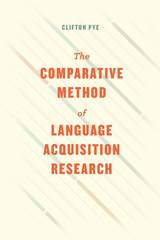 The Comparative Method of Language Acquisition Research
Clifton Pye
University of Chicago Press, 2017 The Mayan family of languages is ancient and unique. With their distinctive relational nouns, positionals, and complex grammatical voices, they are quite alien to English and have never been shown to be genetically related to other New World tongues. These qualities, Clifton Pye shows, afford a particular opportunity for linguistic insight. Both an overview of lessons Pye has gleaned from more than thirty years of studying how children learn Mayan languages as well as a strong case for a novel method of researching crosslinguistic language acquisition more broadly, this book demonstrates the value of a close, granular analysis of a small language lineage for untangling the complexities of first language acquisition.
Pye here applies the comparative method to three Mayan languages—K’iche’, Mam, and Ch’ol—showing how differences in the use of verbs are connected to differences in the subject markers and pronouns used by children and adults. His holistic approach allows him to observe how small differences between the languages lead to significant differences in the structure of the children’s lexicon and grammar, and to learn why that is so. More than this, he expects that such careful scrutiny of related languages’ variable solutions to specific problems will yield new insights into how children acquire complex grammars. Studying such an array of related languages, he argues, is a necessary condition for understanding how any particular language is used; studying languages in isolation, comparing them only to one’s native tongue, is merely collecting linguistic curiosities.
Comparative Musicology and Anthropology of Music: Essays on the History of Ethnomusicology
Edited by Bruno Nettl and Philip V. Bohlman
University of Chicago Press, 1991 Nineteen scholars from five countries explore significant issues in the history of ethnomusicology and its methodological and theoretical foundations, while providing a critique of the discipline.
"This is a useful and enriching collection of articles of interest to musicologists and ethnomusicologists. . . . The authors manage to cover much ground, presenting fascinating insights into the history of the discipline while also exploring new directions in both theory and analysis. . . . the most sweeping work of this kind to be published since the 1960s."—L. D. Loeb, University of Utah, for Choice
 Comparative National Balance Sheets: A Study of Twenty Countries, 1688-1979
Raymond W. Goldsmith
University of Chicago Press, 1985 Raymond W. Goldsmith has combined his experience, good sense, and flair with figures to construct this groundbreaking comparative study of the balance sheets of twenty of the largest nations. A pioneer in the field of national accounts, Goldsmith now presents a work that will be a valuable tool in tracking the economic progress of and between nations.
The majority of the balance sheets were created especially for this project, their components gleaned from fragmentary and heterogeneous data. There are approximately 3,500 entries, each measuring the value of one type of tangible or financial asset or liability at a given date. Goldsmith's estimates are keyed to fifteen benchmark dates in the economic progress of the cited nations, and for twelve nations he was able to construct balance sheets dating back to the nineteenth century or earlier. Combined, worldwide balance sheet are included for 1950 and 1978.
Comparative National Balance Sheets will provide an essential basis for the quantitative analysis of the long-term financial development of these nations. In addition to national balance sheets for all large countries except Brazil and China, sectoral balance sheets for France, Germany, Great Britain, India, Japan, and the United States in the postwar period are also included.
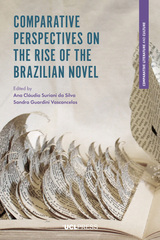 Comparative Perspectives on the Rise of the Brazilian Novel
Edited by Ana Cláudia Suriani da Silva, and Sandra Guardini Vasconcelos
University College London, 2020 Comparative Perspectives on the Rise of the Brazilian Novel presents a framework of comparative literature based on a systemic and empirical approach to the study of the novel and applies that framework to the analysis of key nineteenth-century Brazilian novels. The works under examination were, therefore, published during the period in which the forms and procedures of the novel were acclimatized as the genre established and consolidated itself in Brazil. The 15 original essays by experienced and early career scholars explore the links between themes, narrative paradigms, and techniques of Brazilian, European and North American novels and the development of the Brazilian novel. The European and North American novels cover a wide range of literary traditions and periods and are in conversation with the different novelistic trends that characterize the rise of the genre in Brazil. Chapters reflect on both canonical and lesser-known Brazilian works from a comparatist perspective.
 Comparative Physiology of Vertebrate Respiration
G. M. Hughes
Harvard University Press This book is a concise study of the structure and function of vertebrate respiratory systems. It describes not only the individual organ systems, but also the relationship of these systems to each other and to the animal's environment. For example, the author emphasizes that a proper understanding of respiration involves a consideration of the external environment as a source of oxygen as well as the biochemistry of the cell; and, from the evolutionary point of view, that physiological changes in the respiratory and circulatory systems are dominated by the origin of the land habit.
The author's approach to the subject exemplifies that trend to the amalgamation of Zoology and Physiology, which has become increasingly marked at universities and schools in recent years. This synthesis requires, broadly, a knowledge of classical comparative anatomy, ecology, evolution, physiology and biochemistry; an enormous task, but nevertheless one in which the zoologist holds a central position. This book indicates the nature of such an eclectic approach, with the animal, in its environment and its evolution, as its focal point.
Covering a rapidly changing field of research the author refers to many recent views and indicates where these differ from those commonly accepted.
 Comparative Public Management: Why National, Environmental, and Organizational Context Matters
Kenneth J. Meier, Amanda Rutherford, and Claudia N. Avellaneda, Editors
Georgetown University Press, 2017 While the field of public management has become increasingly international, research and policy recommendations that work for one country often do not work for another. Why, for example, is managerial networking important in the United States, moderately effective in the United Kingdom, and of little consequence in the Netherlands? Comparative Public Management argues that scholars must find a better way to account for political, environmental, and organizational contexts to build a more general model of public management. The volume editors propose a framework in which context influences the types of managerial actions that can be used effectively in public organizations. After introducing the innovative framework, the book offers seven empirical chapters—cases from seven countries and a range of policy areas (health, education, taxation, and local governance)—that show how management affects performance in different contexts. Following these empirical tests, the book examines themes that emerge across cases and seeks to set an agenda for future research. Intended for students and scholars of public administration and public policy, this book will be the first to provide a comprehensive comparative assessment of management’s impact on organizational performance.
The Comparative Reception of Darwinism
Edited by Thomas F. Glick
University of Chicago Press, 1988 The reaction to Darwin's Origin of Species varied in many countries according to the roles played by national scientific institutions and traditions and the attitudes of religious and political groups. The contributors to this volume, including M. J. S. Hodge, David Hull, and Roberto Moreno, gathered in 1972 at an international conference on the comparative reception of Darwinism. Their essays look at early pro- and anti-Darwinism arguments, and three additional comparative essays and appendices add a larger perspective. For this paperback edition, Thomas F. Glick has added a new preface commenting on recent research.
Comparative Socialist Systems: Essays on Politics and Economics
Carmelo Mesa-Lago
University of Pittsburgh Press, 1974 This volume adavnces the methodology to compare socialist systems throughout the world by combining both theoretical approaches and empirical comparisons in a multidisciplinary and systematic fashion. Of the sixteen essays, all but two include the Soviet Union, all refer to Eastern Europe, six include China, and five include Cuba.
Comparative Studies in Administration
James Thompson
University of Pittsburgh Press, 1959
This volume is intended as a contribution to the study of administration. The contributors represent several branches of social and behavioral sciences, including anthropology, economics, industrial management, sociology, and social psychology. The data for the empirical studies were gathered in the United States, Germany, Great Britain, Norway, West Africa, and the Fox Indian society, and from different types of organizations, including manufacturing, mining, shipping, higher education, hospitals, the military, and social welfare agencies.
Contributors: Frederick L. Bates; Warren G. Bennis; Frank A. Cassell; Rose Laub Coser; William R. Dill; Frederick H. Harbison; Ernst Köchling; Walter B. Miller; Stephen A. Richardson; Heinrich C. Ruebmann; Edward J. Thomas; and the editors.
|
|



